
Vintage Toys
Just for Fun!
Visit our other page where we assemble a 1948 Model Airplane Kit
Just in case you have a special request, here are some navigational tools
- Wind-Up Animals
- Mr. Machine (Ideal Toys)
- M-100003 Pressed metal Train (Louis Marx)
- Honeymoon Express (Louis Marx)
- G-Man Pursuit Car (Louis Marx)
- Submarines (Wolverine)
- Drum Major (Wolverine)
- Fresh Air Taxi (Louis Marx)
- Roller Skates, Spring Shoes and a Pogo Stick
- Hopalong Cassidy
- Ranger Joe
- History of the J. Chein Company
- The Ferris Wheel (J. Chein)
- Elephant Bank (J. Chein)
- Filling Station (J. Chein)
- Patriotic Clown Acrobat (J. Chein)
- Clacker Noisemaker (J. Chein)
- Cathedral-Shaped Crank Organ (J. Chein)
- Mechanical Speedboat (J. Chein)
- Alligator (J. Chein)
- Happy Days Bank (J. Chein)
- Bosch Radio Globe (J. Chein)
- Airplane Toys
- Patrol Bomber - Clipper (J. Chein)
- Aquaplane (J. Chein)
- Lockheed Constellation
- World War II Identification Models
- Model Airplane Contests
- Balsa Stick and Tissue Models
- Cleveland Model Airplane Kits
- Berkeley Model Airplane Kits
- Covers of Model Airplane News 1929-1969
- WINGS Friend or Foe Trading Cards
- Rocket and Space Theme Toys
- Tinker Toys
- Banks and Tsotschkes
- Etch-A-Sketch (Ohio Art)
- Complex Mechanical Toys
- The Dogpatch Band (United Art Metal)
- Marx Merrymakers, Ham and Sam (Louis Marx)
- Jazzbo Jim (Louis Marx)
- We have a separate page devoted to Erector Sets
In addition to Toys, we have a Calendar of Swing Dancing in DC, a Directory of Vintage Clothing Stores and a Guide to 1940s Collectibles. Thanks for tuning in! Feel free to Contact Me if you have questions or want to share photographs and toy stories with the rest of the readers.
Hi! -- I love toys but I don't "invest" in them. I'm not an expert in toys -- everything that I show on this page has been with me since I was a child (unless it is explicitly noted)! Sometimes I see some of the things that I enjoyed when I was a kid selling at astounding prices, and it is amusing to report on the price that some people are willing to pay for nostalgia. I do not encourage speculation in toys or any other item. I have reported what I have seen, but this should not be considered an authoritative guide to value. I do NOT buy or sell anything -- I only write about it!
Wind-Up Animals
I have always been a toy collector. Here is a picture taken in 1951. The scene is the rear landing of the slum apartment that my parents had when I was a child. To say that this dwelling was "Down Market" is to be charitable. Amidst this splendor, I had actually managed to acquire a small collection of wind-up animals. The young man on the left is Jimmy Manning, by the way.
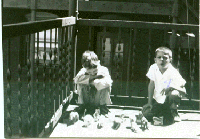
The Collection, Mark I
The Inset (below) shows an enlargement of the toys. All of these were obtained from the drug store and cost somewhere between a quarter and a dollar. I always put the bite on uncles, aunts and anyone else to assist me in collecting.

Closer Look
Why am I showing you this? Well, because I hang onto everything and never let go, I still HAVE three of the six toys. Left to right in the front row of the inset, we have: The Elephant, The Puppy, The Polar Bear, The Donkey, the Squirrel, and The Camel. In the back are some paper stand-up figures that have long since departed this world.
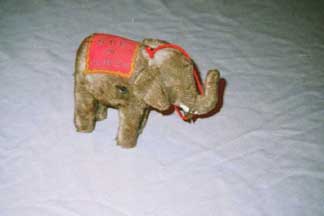
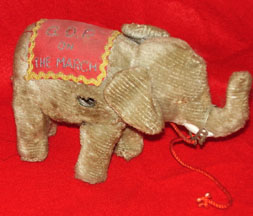

The Wind-up Elephant
Click to Enlarge
The Elephant lumbers along, moving from side-to-side. He has bakelite tusks. The banner on his side says "GOP on The March" and he was a gift from my Uncle Ralph who was the renegade Republican in the family. The Donkey (now missing) was a gift from my father to balance the political spectrum.
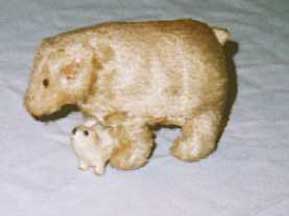
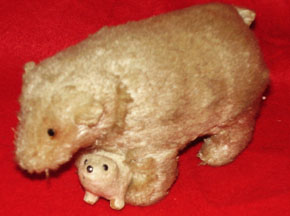
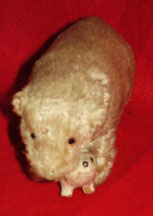
Polar Bear Plush Wind-up Toy from the 1950s
Click to Enlarge
The Polar Bear and Cub was my favorite. As Mama bear lumbers along, her cub looks out from between her front legs.
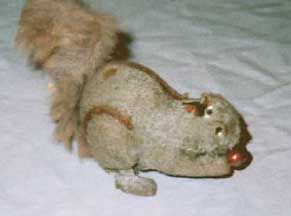
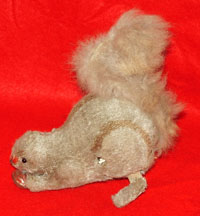
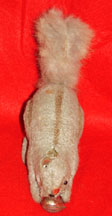
The Wind-up Squirrel
Click to Enlarge
The Squrrel is relatively simple -- he just hops from place to place with a nut in his front paws
All of these toys work perfectly. I even have the original wind-up keys. They also have little blue and white tags that say "Occupied Japan" on them. These were wonderful things for a poor kid in the slums of Pittsburgh. I was, indeed stunned to find that the 2001 Kovel's Price Guide lists the Elephant at $750, the Squirrel at $300, and, joy of all, the Polar Bear at $1,200. I wish that I had the Camel...
Hang on to your toys!
Ideal Toys' "Mr. Machine"
Mr. Machine was a mechanical toy originally manufactured by the Ideal Toy Company in 1960.
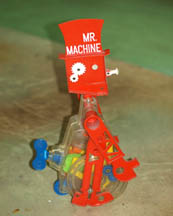
Presenting "Mr. Machine"
Click to enlarge the photo
This is a robot-like figure in the shape of a man wearing a top hat, with mouth fixed in a permanent grin. The head was attached to a mechanical body that had a giant windup key at the back. When the toy was wound up it would "walk", repeatedly ring a bell mounted on its front and after every few steps emit a mechanical "Ah!", as if it were speaking (or belching). The toy stood about 18 inches tall. Here is a video of Mr. Machine in action and here is a commercial for the toy.

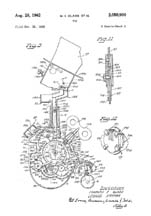
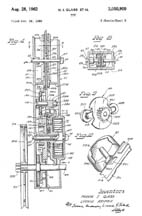
Patent No 3,050,900 for the "Mr. Machine" Toy
Click to enlarge any photo
Check our Patent Page to learn how to get free patent drawings
Mr. Machine was invented by Marvin Glass and Leonid Kripak, both known for creating clever playthings. Here's what the patent description says:
"... This invention relates generally to, and has for its principal object, an animated toy. More particularly, the invention relates to, and has for a further object, a mobile toy including a construction and arrangement of the parts which can be readily assembled and disassembled, which resembles a mechanical man incorporating various interest attracting features, and which are generally fabricated of translucent, differently colored plastic materials so that a fascinating mechanical, multicolored activity is observed during operation of the top. A still further object of the invention is the provision of a toy of the type described which is of inexpensive construction, which has educational value in developing the mechanical skill of a child through assembly, disassembly and operation of the toy, and which will attract and maintain the attention of children over an extended period of time..."What does this mean? The child could not only see all its mechanical parts, but also take the toy apart and put it back together easily, like a Lego toy or a jigsaw puzzle. Indeed, creative, mechanically minded children -- the backbone of our society -- were drawn to the toy and it became one of Ideal's most popular toys
There is an anecdotal story about how the toy got its name: Marvin Glass was a workaholic toy inventor. So much so, that he often did not spend enough time with his wife. During an argument over Marvin's work habits, Mrs. Glass shouted "You are always working, inventing! You are Mr. Machine!". And so a great toy name was coined by Mrs. Glass
Alas, Lawyers, Concerned Moms and Bureaucrats conspired to change Mr. Machine: after 1978 it could no longer be taken apart (owing to the supposed tendency of very young children to put small pieces in their mouths which could be accidentally swallowed or present a choking hazard). Instead of ringing a bell and making the "Ah" sound, it now whistled a politically correct children's rhyme ( "This Old Man".) This, of course only appealed to the non-mechanical, passive, group oriented child that is widely held to be the ultimate development of mankind. (as our society and economy slips into the mud...) The PC version of Mr. Machine was brought back once more in the 1980s. In 2004, the Poof-Slinky Company remanufactured the original 1960 version (using the actual Ideal molds whenever possible) which made the original sounds and could be disassembled, but with the intention of being marketed to nostalgic adults as a collectible. You can still buy one on Amazon for about $100.
The Marx M-100003 Pressed Metal Train
On our way home from the Reading Air Show, I was very fortunate to find this little lithographed tin train:
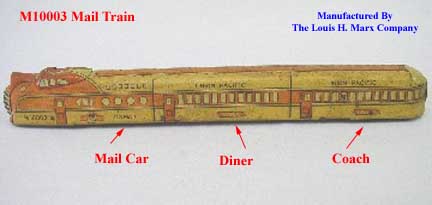
The M-10003 Mail Train, "City of Salinas" [or "Little Zip"]
by the Louis H. Marx Toy Company c. 1934-1935
This is a wind-up model of the first "streamliner" ever made, the Union Pacific M-10000 "City of Salinas." This is a very lovely and historic toy that is the brainchild of Louis H. Marx, the man who kept kids happy for generations:
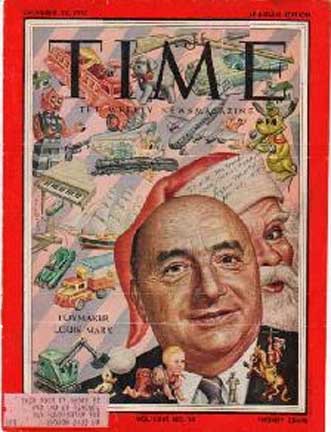
Louis H. Marx
With Santa Claus on the Cover of TIME Magazine, December 12, 1955
This is a nice toy for a child between 6 and 10 because it is virtually indestructible. For a lithographed tin toy, it has a surprising amount of detail and is in approximately the correct proportions as the original. However, as little boys get older than 10, they start to notice that the toy does not have the amount of versimilitude that they would expect, especially if they could go down to the railyard and see the thing "in the flesh" as it were.
Details enough to please the "big boys" from ages 10-75 may be found in a precision die cast "O-Scale" model offered by a German Company (for only $1,000 US), as shown below:
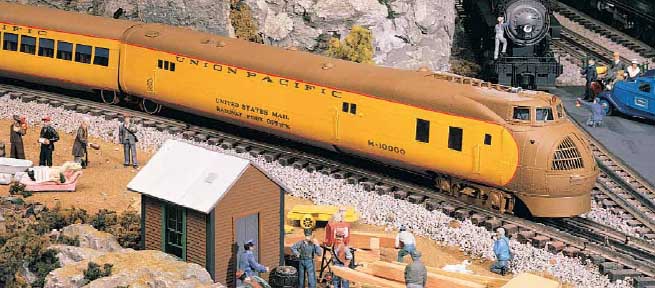
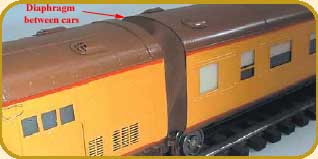
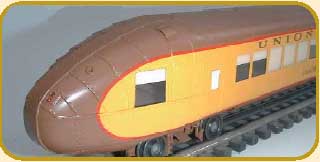
"O" Scale Model of the Union Pacific M-10000 from Sunset Models
Is This Enough Detail For You OLder Boys?
Formally known as "The City of Salinas", this train quickly became known as "Little Zip" because it could be seen whizzing along at over 100 mph powered by a 600 hp spark ignition power plant (similar to an auto engine, but much bigger...) It represented the pinnacle of aerodynamic design for 1934. As shown in the Marx toy model, this was originally a 3 car train. While on display at the Chicago World’s Fair in 1934 a sleeper Overland Trail was added. All the cars werre permanently attached to each other and gap between the cars was covered by an insulated leather and rubber "diaphragm" -- from inside the train, it appeared to be one long room from the Head Car to the streamlined "Beavertail" -- all of the cars had motors, so there was no "locomotive" -- only a front car where the engineer steered the train. Here is the Patent Diagram for the M-10000
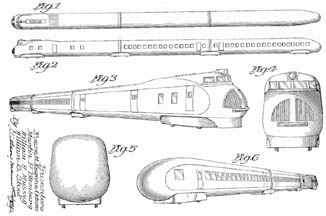
Patent Diagram for the M-10000
Click to Enlarge the Diagram
Click here if you want to learn how to get Free Patent Drawings
History of the M-10000
Feeling the effects of the Depression and declining business, America's railroads were looking for ways to reinvigorate passenger travel. As Ralph Budd, president of the Chicago Burlington & Quincy, later explained, railroads had to continue running trains on short routs to handle mail and baggage "whether or not anyone rides the trains." Budd was inspired after seeing GM's powerful diesel engines and Pullman's Railplane. He concluded that what the railroads needed was a new kind of train that was fast, convenient, ultramodern and luxurious enough to fire the public imagination. The Union Pacific Railroad also saw the two exhibits and came to similar conclusions. A race was on to see which of the two railroads would be the first to develop an ultramodern diesel passenger train.
With the engine technology of the day, the new trains had to be lightweight. To get the most out of the available power, the trains were streamlined. The Union Pacific selected the University of Michigan to find the best aerodynamic shape while CB&Q turned to M.I.T.. The new designs looked like nothing else that had ridden the rails. They looked more like Buck Rogers's space ship than a train. People were tired of living in the Depression, they were ready for a change and these drastic new body designs, no doubt, capitalized on it.
Both companies turned to General Motors to supply the power plant, but, they selected different car builders. Union Pacific used to the established Pullman Company to build their cars. Like the Railplane, the UP train was constructed out of aluminum. In the other corner, CB&Q looked to a new comer on the railcar scene, Edward G. Budd Manufacturing Company (no relationship to Ralph Budd). Budd had been producing auto-bodies before the Great Depression; however, with business down, they decided diversify and construct a light weight, stainless steel railcar. They finished their first coach in 1932. The stainless steel coach was made possible because the Budd Manufacturing Co. had developed the first successful method of welding stainless steel only a few years earlier. Prior to Budd's innovation, stainless steel was used only for cutlery and surgical instruments.
Pullman was able to accelerate the construction of the UP train, however, General Motors was unable to deliver a diesel power plant at an earlier date. So, to win the race against the CB&Q, the Union Pacific decided to use a distillate (gasoline) engine instead. The M10000 was delivered to the UP on February 25, 1934. General Motors was able to complete a diesel electric power plant for CB&Q's later delivery date. CB&Q received the Zephyr in April, 1934. Both trains were actually three car articulated motorcars, but that hardly mattered to the public. The new trains were immensely popular.
Both railroads embarked on a massive publicity campaign, sending their trains to newsworthy sites. Here is the M-10000 at the site of Boulder Dam, actually using the construction railway and not the regular commercial right of way. VIPs were carried directly to the site of the dam construction and even into the gigantic penstock tunnels. This was posssible because the train was small and light. Much of the right-of-way covered in this boulder Dam visit is now underwater.
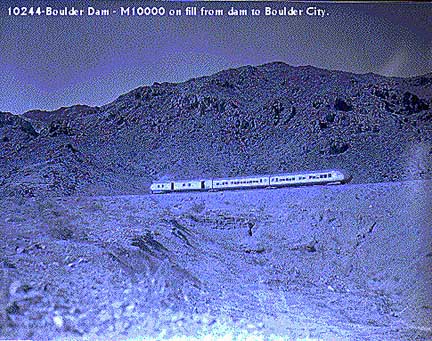
The M-10000 "City of Salinas" at Boulder Dam
c. 1934-1935
Both railroads were unsure of what the new trains could do or how reliable they were. After the initial fanfare died down, the high speed trains were put into service on relatively flat, lightly traveled, short distance runs that could easily be completed in a single day. In such a fashion the trains were given the opportunity to prove themselves, but if they were to fail, it would not be a catastrophic disaster. The M10000 was a mild success, but the Zephyr was a huge success. Before the end of 1934, eight major railroads had ordered high speed diesel powered trains. This Website shows all the streamlined trains of the 1930s.
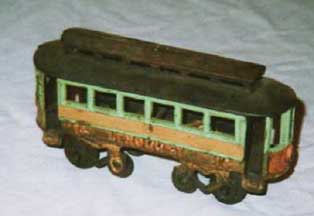
Cast Iron Trolley
Click to Enlarge
This is a little cast iron Trolley (#14) It has no other markings, but it is very nice.
Honeymoon Express
If you haven't looked at the M-10000 Streamliner (immediately above), you should do that before you get very far into the next toy:
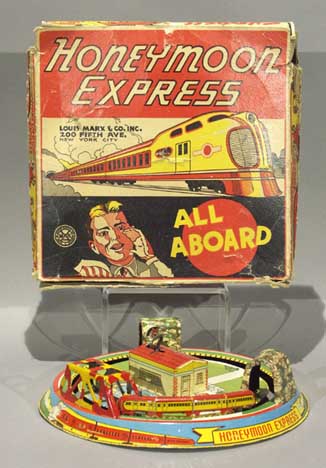
The Honeymoon Express One of Louis Marx's Most Endearing Toys
This is a wonderful toy for young children -- the little train races endlessly around the track, passing through two tunnels and a bridge. Kids will sit and watch this thing forever -- at least as long as the spring-wound motor will drive it (about two minutes). It is very simple -- a spring motor is in the "station" (the little thing that looks like a house in the center). The spring is wound with a key. A series of reduction gears transmits motion to a main axle which has several radial arms that are connected to the train. A small lever on one of the tunnels allows you to regulate the speed by a friction buffer wheel. A push-button on the engine engages a catch that will hold the train in position (it is effectively an "on/off" switch)
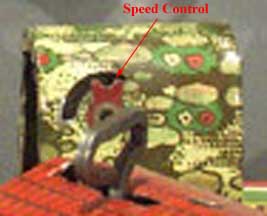
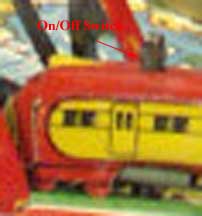
Controls for the Honeymoon Express
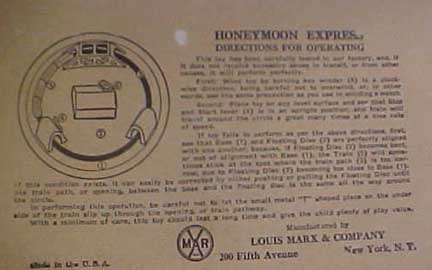
Instructions for the Honeymoon Express

Underside of the Honeymoon Express
No Rocket Science Here
I know that this is an original Honeymoon Express toy probably from 1934, because I received it as a bequest from my cousin Serafino. When he enlisted in the Army, he packed all his things in a wooden box and said that if anything ever happened to him, I should get them. Unfortunately, he died in action in the Korean War. I kept the box of toys at my Dad's house and it got shuffled around. When my father passed away, his second wife (not my Mom) stayed in the house for some time. When she moved to Florida early in 2005, she sold the house. While she was cleaning out the attic, she found the box that Serafino had left me, so I received a "Time Capsule" from 1953. I was thrilled to find a "Honeymoon Express" in the original box.
This is the oldest Honeymoon Express toy that I have ever seen -- my guess is that it is from 1927 or before because it has a "patent pending" notice on it. The graphics are wonderful and evoke the feeling of an unhurried childhood that could wonder in the mechanical mysteries of the steam locomotive.
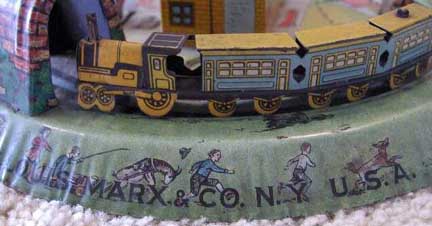
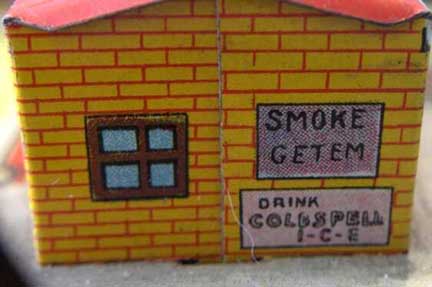
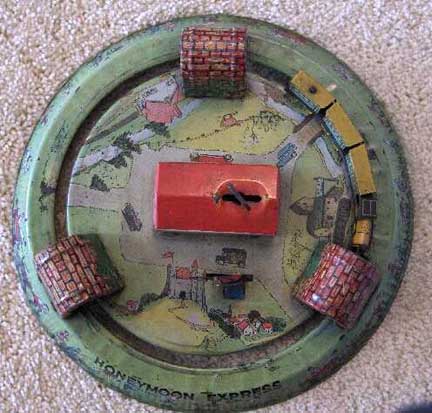
The Honeymoon Express -- 1927 Model
No Streamliner Here
Why is it called a "Honeymoon Express"? A play called the "Honeymoon Express" starring Al Jolson, had been all the rage on Broadway in 1918, running for 356 performances and touring for 6 years. The play was revived on Depression-ridden Broadway of the mid 1930s to rave reviews.
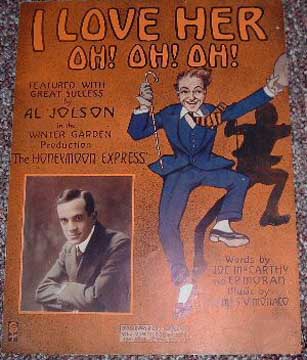
Music from "The Honeymoon Express"
"You Made Me Love You" was the most famous song from the play
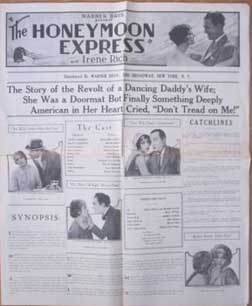
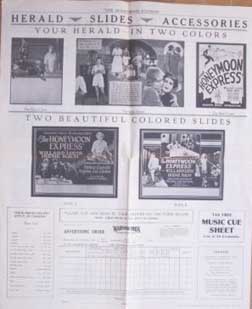
Press Kit for "The Honeymoon Express"
Cast, Synopsis and "Catch Lines"
The Dancing Daddy's Daughter was a Doormat UNITIL
Something Deeply American cried "Don't Tread on Me!"
Freudians may enter the mind of the [then] toy developers and speculate about the darker implications of a little train endlessly going into and out of tunnels. However, my guess is that the toy is named for the play...
There is no doubt that the toy struck some kind of chord because the Marx Company reissued more than 40 versions of this toy into the 1960s and it always sold well. There was no limit to the number of ways that the toy could be re-painted or "re-dressed" to appeal to kids. One of the very first modifications was to include a second connection to the motor shaft that would permit an airplane to be added to the display. Some models have a clever reversing gear to permit the airplane to fly in the opposite direction of the train. Here is one of the earliest airplane versions that is also dressed to incoprorate a popular cartoon character. This toy is owned by my reader Horace from Decatur, Georgia and may be the finest surviving example of the "Honeymoon Express." I am very grateful to Horace for sharing them with us!
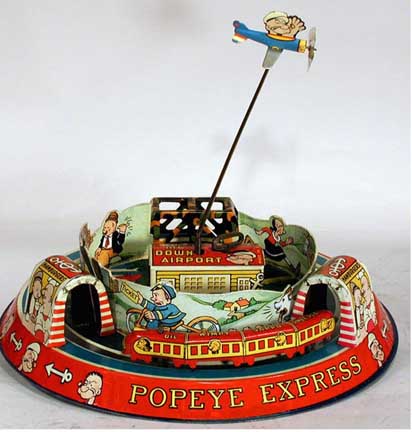

The Popeye Version of the Honeymoon Express
Train and Plane
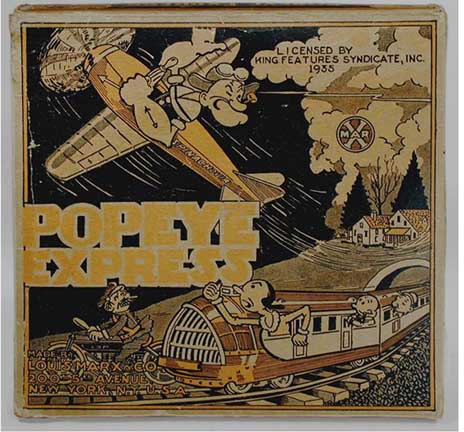
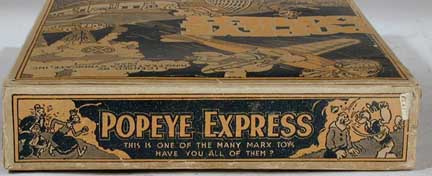
The Original Box for the Popeye Version
Astoundingly Good Condition!
Here is another "re-dress" of the toy as the "Mickey Mouse Express"
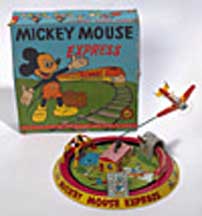
The Mickey Express
Note that these two early versions of the toy have a representation of the M-10000 Streamliner on the box and as the little toy train. Here is a box from the 1940s that shows that the train has been "adjusted" to reflect the most modern Diesel trains with an E-8 Locomotive.
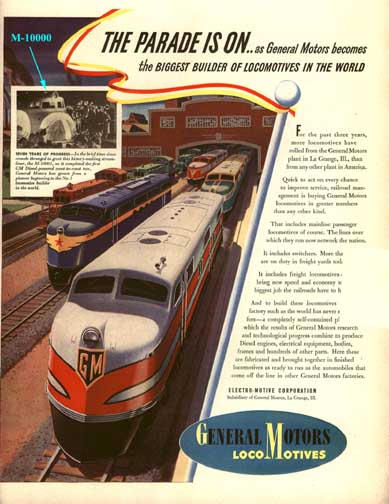
Technology Advances from the M-10000 to the E-8
We note that some train signals have been added and that the little box that holds the motor has been changed from the "Glendale Train Station" to the "Honeymoon Cottage."
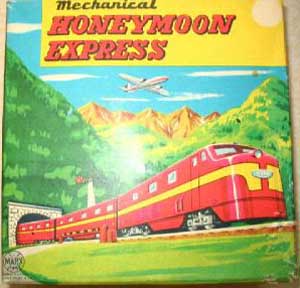
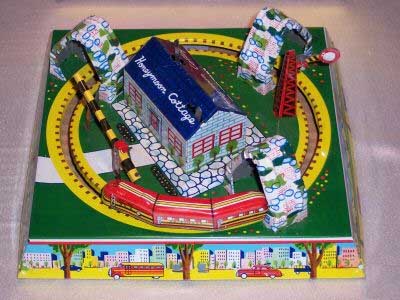


1940s "Re-Dress" of the Honeymoon Express - from City to Country
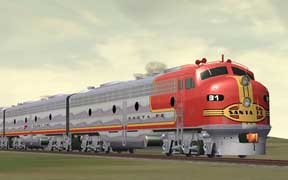
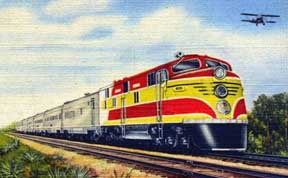
The EMD E-8 Diesel Locomotive in (l.) ATSF "War Bonnet" Colors (r.) Florida Champion Colors
EMD = "Electromotive Division, American Locomotive Works"
ATSF = "Acheson, Topeka and Santa Fe Railroad"
"War Bonnet" - Red: the Chief's Face, Yellow: War Paint, Sliver cars: Feathers
The "Florida Champion" was an exclusive train that ran from New York to Miami
Here is a later version that has been re-dressed to suggest "New York City" with skyscrapers, brownstones and much more elegant tunnels and bridges. This is an early set and at one time, it had a little airplane as well. I really like this one!
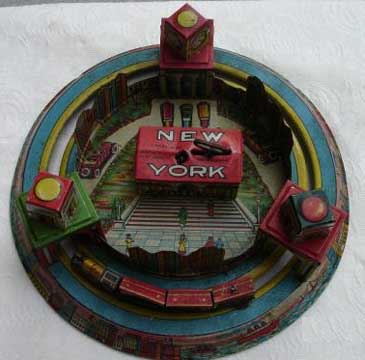
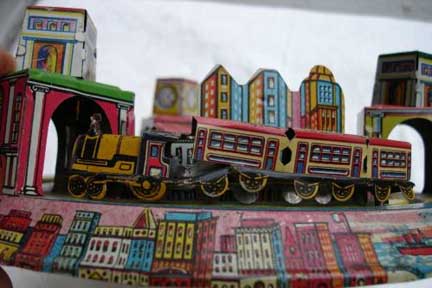
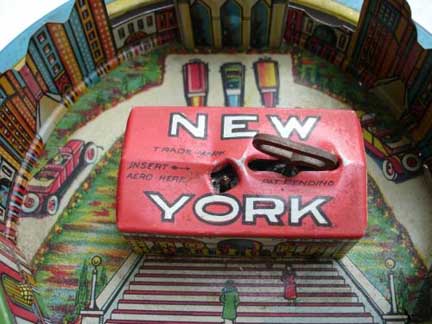
The New York Version of the Honeymoon Express
This moves us to the 1960s when the "Honeymoon Express" was recycled as the "Subway Express." In this case, the train runs entirely in a little plastic "tunnel" -- perhaps kids could fantasize about having X-Ray vision or something!
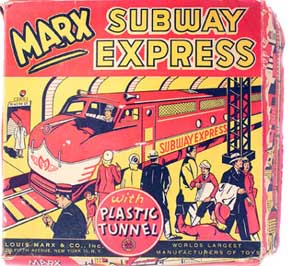

The "Subway Express"
X-Ray Vision
Finally, I was very concerned when a reader sent me this photo from the internet:
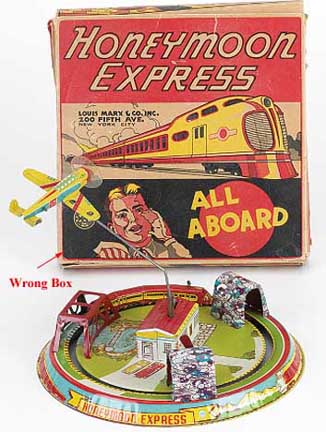
Problematic Honeymoon Express
The Box and the Toy Don't Appear to Match
According to my reader, the toy was being offered for a large amount of money, principally due to the presence of the original box. This certainly looks like an original box, but you will note that the toy has an airplane. Also, you will note that the speed control is not original either. The airplane, a low wing monoplane with a "greenhouse" canopy, is from much later than 1934. Also note that the airplane is not pictured on the box. So, from what I can see, the toy and the box don't match -- what's wrong with that? Well, a bit more research turned up the fact that you can actually BUY "Exact Reproductions" of the Original Box. The photo that the reader sent me gives me quite a bit of concern. Personally, I would not be interested in that particular object, because I would have too many questions. I would certainly not want to buy it in an electronic auction. If you want to buy a "Honeymoon Express" toy, I reccommend that you look at it very carefully and buy it because you like it, not for investment value. There are so many of them out there that it would be fairly easy for an unscrupulous operator to mislead the unwary public. Get the opinion of a reputable person before you spend any more than $25 on one of these things!
Submarines
Here are two pressed metal submarine toys. Take a look at them first:
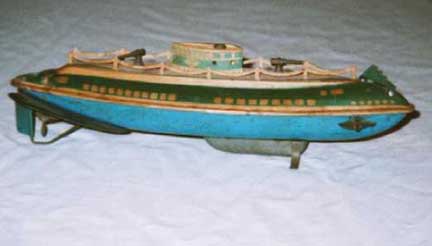
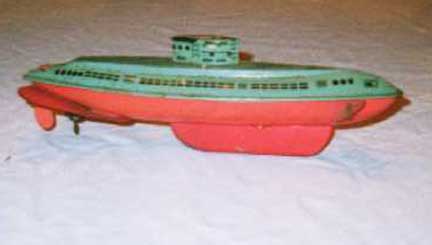
The Wolverine Wind-up Submarine
(Top) World War I Sub Model
(bottom) World War II Sub Model
Click to Enlarge
Both of these toys were made (in the USA) by the same company, "Wolverine Supply and Manufacturing Co." of Pittsburgh. (That's how I got hold of them) They are substantially the same toy, differing only in the trimming. The Blue sub dates from the 1920s and the Red sub was made in the mid 1940s. Note that the older toy has MUCH more detail -- there are little deck guns, a railing and a net cutter on the bow. The newer toy has many of the same details simply painted on. The delicate railing would probably be the first thing to disappear on the WWI version and I am surprised that my sub still has it. Both were made from the same dies, and simply "dressed" to look like submarines of each period. Cost-cutting may also have played a role.
Our reader Scott found this (below) version of the same Wolverine Sub -- note that it is midway between the WWI and WWII versions: it still has the net cutter and 3-dimensional guns, but the process of "abstraction" has clearly begun.
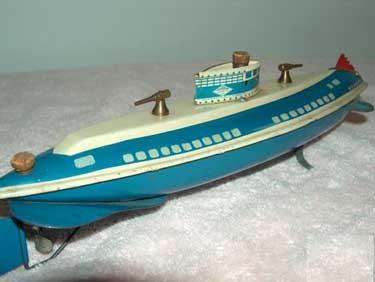
Wolverine Sub, Interim Version
These things actually work --- well, they used to work when I was a kid, even though you'd have to be a nut to stick these things in water today. You insert a winding key into the slot in the conning tower, tighten the spring, and hang on to the propellor. Then you set the bow planes. Stick the thing in a swimming pool and let the propellor go. It will skim along, take in water through a hole in the stern and slowly "dive". The counterweights on the bottom just offset the buoyancy of a sealed tube in the center. The thing will actually run nicely underwater the whole length of a swimming pool. In excellent condition, the WW1 sub could be worth about $300 now and the WW2 version about $200 --- mine are NOT going swimming.
Here's another example of the contunuous re-use of designs to keep production of toys going for quite some time. Remember, the expensive part is changing the "dies" that are used to press out the metal parts. The cheap part is how you pait the thing. We want to thank our friend Lloyd Olson for putting us onto this.

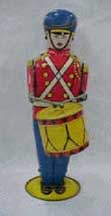
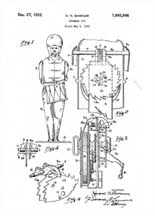
The Famous Wolverine Drum Major
(left) Wolverine Drum Major, circa 1933
(middle) Wolverine Drum Major, circa 1950
(right) The Patent Diagram for the wolverineDrum Major (No. 1,892,546)
Click to Enlarge
The tin toy drummer, "Drum Major No. 27" by Wolverine has a 1933 patent date 1892546 is shown in the Top photo. It is about 13 1/2" tall and has a rectangular base measuring 4 1/2" by 6 1/2".T he windup key goes in the back. The 1950s version is shown in the second photo. The 1933 version is worth about $350-$400; the 1950 version is worth about $150.
History: Wolverine was founded in 1903 by Benjamim.F. Bain in Pittsburgh, Pennsylvania. The company originally made and repaired tools and dies. A toy manufacturer contracted with Wolverine to manufacture the tools to build a toy. When the contracting toy company went out of business, Wolverine used the manufactured tools to begin their own line of toys. The Drum Major was designed by Howard N. Barnum of Cleveland, Ohio and was pateneted on December 17, 1932. Note that the spring-wound motor turns two pawls that alternatively raise and lower each arm.
Of all things, the Drum Major toy has a bit part in a 1953 film, The Bigamist directed by Ida Lupino and starring Dana Andrews and Joan Fontaine. A couple who have been married for 8 years, and can not have children, wish to adopt one. When going through the form-filling procedure, Mr. Graham (Andrews) pauses very noticeably at one form which allows the adoption agency to delve into their private lives and "check him out", if you will. The reason for this pause is told in retrospect to the agent (Edmund Gwenn of "Miracle on 34th Street fame) after it is found that he not only has another wife, but a son by her. Joan Fontaine was the standout star from this film. Just watch her face in the final courtroom scene - her expression really speaks a thousand words. A short film, but utterly compelling. If you get the chance to see it - do!
We got this note from our reader Eddie, who writes:
"... Just a quick note to say thank you for publishing out on the internet the wealth of information on toys, one in particular the Drum Major. I was fortunate enough to pick up one in excellent condition through Ebay and I love it. I got the earlier one (yellow). There was a 50's one but funny thing is that it went for 3 times the amount of money than the yellow...I guess people thought newer looking (bright colors, etc) was worth more. ..."
This is the value of information to a knowledgeable customer.
One of the good things about "knowledge" is that it can help you find bargains. As a case in point, I have always coveted the Marx G-Man Pursuit Car because it is stylish and outrageous at the same time. It evokes the frustration of the mid 1930s when gangsters were armed to the teeth and FBI agents couldn't even carry a gun. The gangsters had souped up Ford V-8s (or whatever other fast car they could steal) while Law Enforcement had to make do with downmarket vehicles. For a while, it seemed like John Dillinger, Machine Gun Kelly, Pretty Boy Floyd and their ilk could outrun the Law any time they chose.
Exasperated by front page headlines of lawlessness, the Democratic-majority Congress passed, and President Roosevelt signed, the Weyburn Bill, which granted the FBI arrest powers and authorized its agents to carry firearms. Eventually, all branches of Law Enforcement were given weapons and vehicles of commensurate ability as their Opponents. In FBI mythology, the nickname "G-Man" is held to have originated during the arrest of gangster George "Machine Gun" Kelly by agents of the Division of Investigation (DOI), in September 1933. Finding himself unarmed, Kelly supposedly shouted "Don't shoot, G-Men! Don't shoot, G-Men!" This event is dramatized/idealized in the 1959 film, The FBI Story, where its somewhat implausible quality is in no way diminished.
In a sense, the G-Man Pursuit Car (c. 1935) symbolizes America's hopes that Good will defeat Bad.
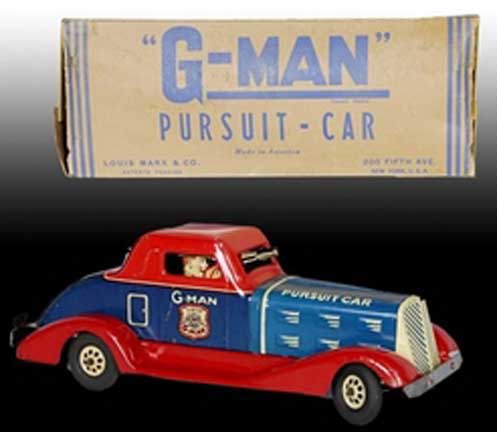
The G-Man Pursuit Car, Louis Marx Toy Company, c. 1935
Moving Out With Machine Guns Blazing
But Who Was Driving the Car?
The pressed tin lithograph toy is quite striking and fairly big for a toy (it cost 92 cents back then, equivalent to about $30 today). The car is powered by a spring motor that also drives a friction spark-wheel, giving the impression that the machine gun is firing as the car rolls along. This, in turn, allowed young boys to fantasize about mowing the Bad Guys down (while conveniently ignoring any collateral damage). There is only one figure inside the car, and he has both hands on the machine gun and correspondingly, none on the steering wheel. The gun that has more resemblance to a Lewis Gun than the more familiar Thompson Submachine Gun that is generally associated with Cops and Robbers during the Depression.
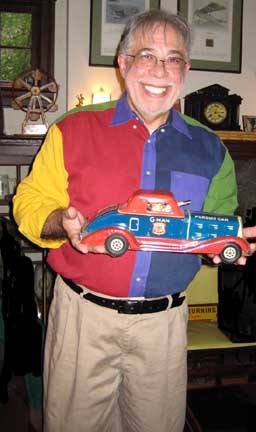
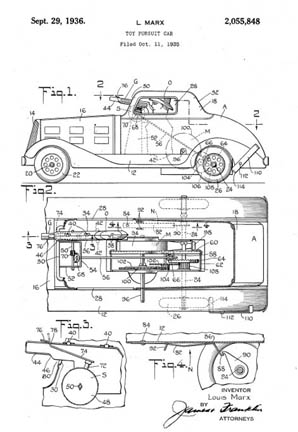
The Benefits of Knowledge
Click on the Patent Diagram to enlarge it
Learn how to get Patent Drawings for Free
OK that's the "knowledge". I went to an "estate sale" in Potomac and found the G-Man car in its original box, hidden in a large pile of kitchen and bathroom products. It did not have a price tag. I bundled it up with a couple of boxes of rancid Corn Flakes, Foot Powder and the like. This sale must have been held by some lady who collected teacups, because she only wanted $25 for the lot -- and since it was the last day of the sale, she cut the price in half! As you can see, I was quite happy with my purchase. All is fair in estate sales....
Roller Skates, Spring Shoes and a Pogo Stick
Back in the old days, kids did not have fancy rollerblades or even skates with an integral boot. Rather, they used steel skates that were clamped on to the shoes. The device used to effect the clamping was a "skate key" -- a form of wrench that tightened the to clamp. The skates could also be lengthened and shortend by using the other end of the skate key to loosen and tighten the nut in the middle.

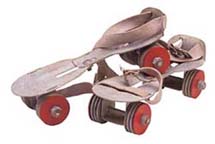
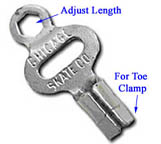
Steel Roller Skates
Skate Design Patent D-110,722
Click to Enlarge Photos
Learn how to get Patent Drawings for Free
Here is a pair of "Satellite Jumping Shoes" distributed by the Rappaport Brothers in the mid 1950s.
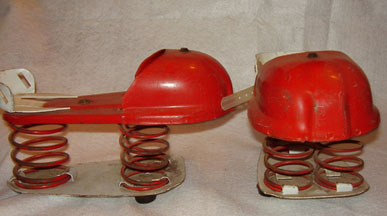

Spring Shoes
Click to Enlarge Photos
Of all things, a modern version called "Moon Shoes" is being sold this very day, right under the noses of product liability lawyers and Concerned Moms. How about that!
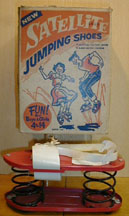
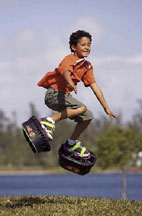
Spring Shoes, then and now
Click to Enlarge Photos
A man named George Hansburg devised a “Pogo Stick” in 1919. The Gimble Brothers Department Store in the U.S. imported a boatload of them, but unfortunately, the sticks rotted on the wet ship ride over. The folks at Gimble asked Hansburg to produce something more resilient, and Hansburg eventually did just that—from his own factory called SBI Enterprises. And those sticks, called “Master Pogos,” were the bouncing wonders that we know and love today.
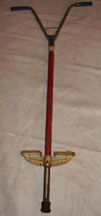
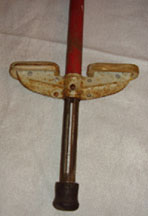

The Pogo Stick
Hansburg Patent No. 2,793,036
Click to Enlarge Photos
Learn how to get Patent Drawings for Free
The Pogos were incredibly popular in the 1920’s—because if you had two left feet and couldn’t jitterbug, at least you could jump. Hansburg taught the Ziegfeld Follies how to bounce, and from there on out, showmanship and the Pogo just sort of went hand in hand. The New York Hippodrome chorus girls performed entire shows on them, marriage vows were exchanged on them, jumping contests were held, and world records for most consecutive jumps were set, and then re-set again.
Here's a video of CNN Anchor Kiran Chetry using a Pogo Stick.
Amos 'n' Andy was a situation comedy based on stereotypes of African-Americans and popular in the United States from the 1920s through the 1950s. The show began as one of the first radio comedy serials, written and voiced by Freeman Gosden and Charles Correll and originating from station WMAQ in Chicago, Illinois. After the series was first broadcast in 1928, it grew in popularity and became a huge influence on the radio serials that followed. The program ran on radio as a nightly serial from 1928 until 1943, as a weekly situation comedy from 1943 until 1955, and as a nightly disc-jockey program from 1954 until 1960. A television adaptation ran on CBS-TV from 1951 until 1953, and continued in syndicated reruns from 1954 until 1966.
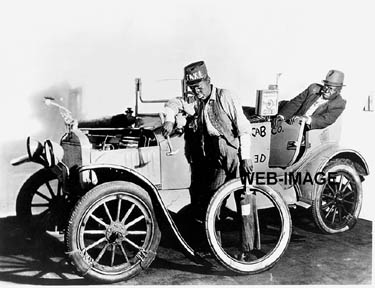
The Fresh Air Taxi
Freeman Godsen and Charles Correll in Blackface
This Blatant Stereotyping Was America's Most Popular Show from 1929 to 1955 Click to Enlarge Photos
Learn how to get Patent Drawings for Free
The Story: Amos Jones and Andy Brown worked on a farm near Atlanta, Georgia, and during the episodes of the first week, they made plans to find a better life in Chicago, despite warnings from a friend. With four ham and cheese sandwiches and $24, they bought train tickets and headed for Chicago, where they lived in a State Street rooming house and experienced some rough times before launching their own business, the Fresh Air Taxi Company. With the listening audience increasing in the spring and summer of 1928, the show's success prompted the Pepsodent Company to bring it to the NBC Blue Network on August 19, 1929. At this time the Blue Network was not heard on stations in the West. Western listeners complained to NBC that they wanted to hear the show. Under special arrangements Amos 'n' Andy debuted coast-to-coast November 28, 1929, on NBC's Pacific Orange Network and continued on the Blue. At the same time, the serial's central characters -- Amos, Andy and George "The Kingfish" Stevens -- relocated from Chicago to New York City's Harlem.
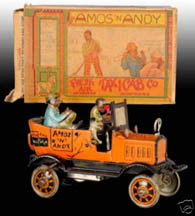
The Marx Fresh Air Taxi Toy (and original box...)
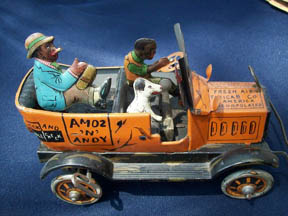
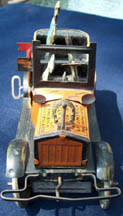
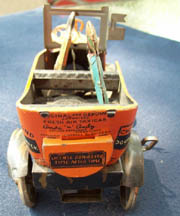
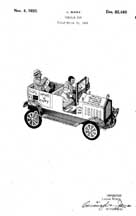
Louis Marx Company Design Patent D-82,440
Click to enlarge photos
Learn how to get Patent Drawings for Free
Hopalong Cassidy
In 1950, I, like alost every other six year old, was a NUT for Hopalong Cassidy. The "Hoppy" craze made Pokemon look very small. Here is a picture of me in full Hoppy regalia. That's my dad on the left. He's wearing a complete Hollywood outfit with gabardine shirt and high-waisted trousers. The photo was taken outside our modest flat at 3625 Liberty Avenue, just across the street from a brewery.
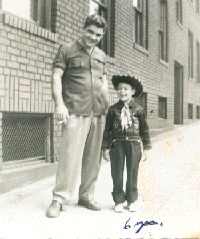
The Hoppy Suit
All that I have left of the Hoppy period is my Milk Tumbler. I wish that I had some of the rest -- In addition to the fond memories, the cap guns would be worth $100 each, the jacquard knit sweater, $50, etc, etc. I am lucky to have my glass. I insisted on having a glass of milk from it every morning and every evening. Because, Hoppy Says,"When milk for breakfast is the Rule, you're smart as any kid in school."
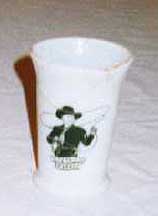
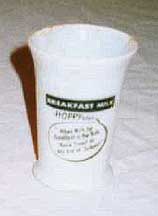
Hopalong Cassidy Tumbler
Hoppy's Picture on the Front
Hoppy's Wisdom on the Back Click to Enlarge Photos
There are two more verisons of this glass, but I have only seen them at High End toy shows. I don't know if future children will have anything "real" to play with. The same computers that make it possible to share these things with you also provide hours of entertainment for kids that are a whole lot more engaging than sitting in a drab sooty apartment dreaming that you are riding on a white stallion ridding the world of "bad guys"
History: Hopalong Cassidy was a character in a series of twenty-eight books written by Clarence E. Milford, first published in 1907. Movies and television shows were made based on the character. The best-known actor playing Hopalong Cassidy was William Lawrence Boyd. His first movie appearance was in 1919, but the first Hopalong Cassidy film was not until 1934. Sixty-six films were made. In 1948, William Boyd purchased the television rights to the movies, then later made fifty-two new programs. In the 1950s, Hopalong Cassidy and his horse, named Topper , were seen in comics, records, toys, and other products. Boyd died in 1972.
Ranger Joe
From 1946-1954, I also ate a whole lot of Popped Wheat (and Rice) Honnies mainly because they were disgustingly sweet but also because they sponsored radio programss by another heroic cowboy --- Ranger Joe.
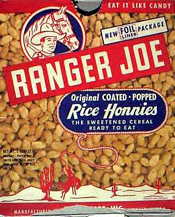
The Box for Ranger Joe Cereal
The Rice version
Ranger Joe (1939) may have been the first presweetened "sugar coated" cereal. They encouraged you to eat this cereal like a sweetened snack right out of the box. Renamed Wheat Honey's in 1954 when Ranger Joe was replaced by Buffalo Bee. They offered a whole lot of premia, some of which I have managed to hang on to:
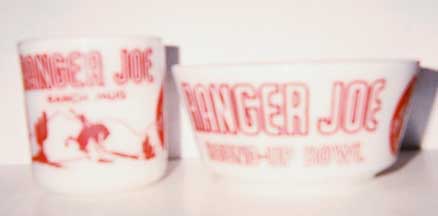
Ranger Joe Mug and Bowl
Marked AH on bottom.<
The child size white glass mug is 3" tall with a diameter of 2.75".
Produced in 1951 as a premium for Ranger Joe Honnies cereal
Ranger Joe was a NBC-TV Saturday morning show from 1951-52
Click to Enlarge Photos
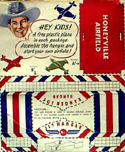
A Hangar for a Toy Plane
For some reason, avaition-related toys seemed to be featured --- you made hangars for them out of stuff on the boxes. They also had a big catalog of stuff that you could buy with Ranger Joe Money which could be found inside the cereal. They really encouraged little kids to eat this stuff --- maybe the Dentists were behind them...
The Hazel Atlas company made four Ranger Joe children's pieces, a cereal bowl, plate, tumbler and mug and they were made in blue as well as red. The heavy milk white glass with the bright pyroglaze designs have held up well over time. There seems to be a plentiful supply of bowls and mugs but the tumblers and plates have been more difficult to locate --- I broke mine and I have not seen any at flea markets.
New Acquisitions
Julius Chein Toy Company
Here are some toys that I have purchased in the past few years, mostly at thrift stores and yard sales. Real metal toys are getting scarcer and scarcer. Some of my favorites were made by the J. Chein Company of New York City, New York and Harrison, New Jersey. The company was in business from 1903 to 1979, specializing in tin mechanical toys, banks, drums, and tea sets. Tin toys were lithographed. Chein's line of comic and circus tin toys received wide acceptance in the 1930s and leading up to World War II.
Here is a history of the logos used by the Chein company (later Chein Industries). They can be used to ascertain the approximate date of manufacture of toys. This is important because many items were made without change for thirty years.
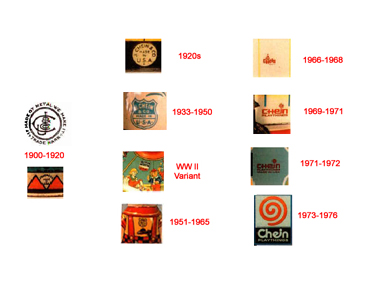
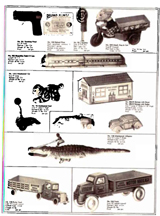
J. Chein Label History
Catalogue Page from the 1930s
Click to Enlarge
These toys were made by a complex process: (1) The "flattened out" Design for the toy is finalized (2) Designs were lithographed on sheet metal; (3) the metal was pressed into shape in machines using dies; and (4) the small parts were assembled by people with nimble fingers. This is shown below:
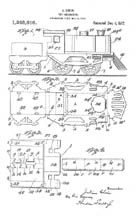
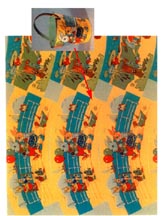
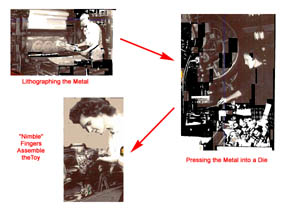
J. Chein Manufacturing Process
(left) The Patented Pattern (No. 1,248,616)
(middle) Design lithographed on the metal sheet
(right) Schematic of Manufacturing Process
Click to Enlarge
Ferris Wheel
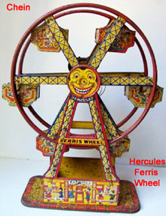
J. Chein Ferris Wheel
Click to Enlarge
This is the No. 172 "Hercules" Ferris Wheel was made from the 1930s to the 1960s. Prior to 1959, the wheel has six spokes and six gondolas. After 1959 (in a cost cutting move...) the wheel only had four spokes and gondolas. The clown face at the center of the wheel is used over and over in Chein products, as is the name "Hercules".
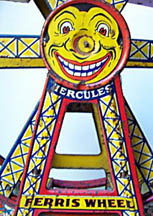
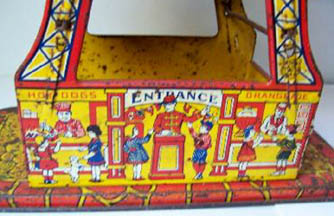
Closeups of the Ferris Wheel (1)
(left) "Hercules" the Clown
(right) Detail of Entrance with Happy Children
Click to Enlarge
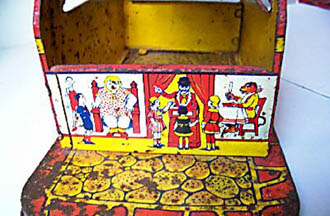
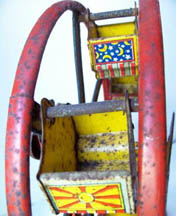
Closeups of the Ferris Wheel (1)
(left) Detail of The Sideshow (reverse of Entrance)
(right)Gondolas (cars) on the Ferris Wheel
Click to Enlarge
Chein toys made extensive use of primary colors, especially red, yellow and blue. The graphics portray happy children in an idealized setting. Over time, the dress of the children changed to reflect current fashion.
Elephant Bank
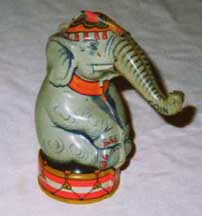
J. Chein Pressed Tin Elephant Bank
Click to Enlarge
This is a very nice pressed metal toy made in the USA by "J Chein & Co.". A lovely Indian elephant (with a Mandala on his head) sits on a drum. You put a coin in the trunk and then pull his tail. The trunk rises as if he were trumpeting and the coin rolls into the bank. This is very nicely molded and in excellent shape. He was made between 1950 and 1960 and is worth about $150 in good condition.
Gasoline Pump and Station Wagon
Here is a really nice Chein toy: it is a kid's version of what is now an antique gas pump. This would have been "cutting edge" technology in 1926, however. In the old pumps, you had to move the gasoline from the tank into the dispenser by turning a crank. When you could see the correct amount (and color) of fuel in the glass, you opened a valve and gravity drained it into your car. This proceedure assured consumers that they were getting the correct amount and quantity of gasoline.
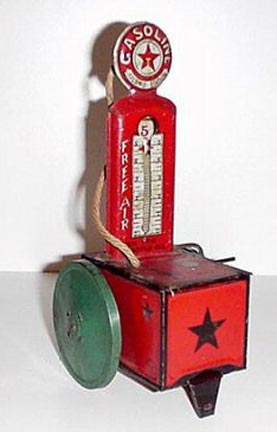
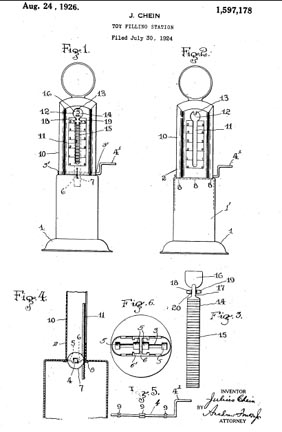
The Filling Station Toy
Click here if you want to learn how to get Patent Drawings
This is a little streamlined station wagon. The license plate is "H137" -- a very clever reference to the fact that this toy is Number 137 in the Chein Catalogue.
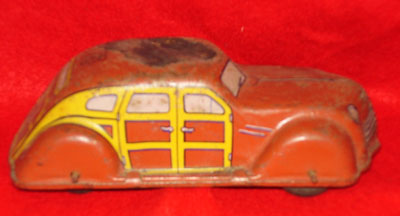
J. Chein Pressed Tin Station Wagon
Click to Enlarge
Mechanical Acrobat and Penguin
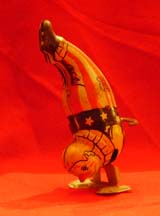

J. Chein Patriotic Clown Acrobat "Walker"
The Same Mechanism Dressed Up as a Penguin
Click to Enlarge
The Chein company made a huge number of walking toys all based on the same mechanism. This is an unusual example of a clown (in patriotic costume) walking on his hands. The toy balances very well and works flawlessly (Chein Catalogue No. 158). The same mechanism was used for the walking Penguin, who is Catalogue No. 152.
You will be surprised to know that Mr. Chein also invented the "clacker" a rather ubiquitous Halloween and New Year's staple. They certainly make a lot of noise! In Chein Catalog terms, this is No. 75 the "Fano-Drum".
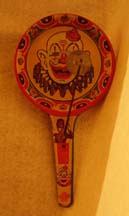
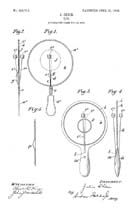
The Clacker
Click here if you want to learn how to get Patent Drawings
Cathedral Organ
This Chein Catalog number 130 -- a crank music box in the shape of a church organ. This was produced from the 1930s to the late 1950s. It played a complete religious song when cranked. It's about 10 inches high.
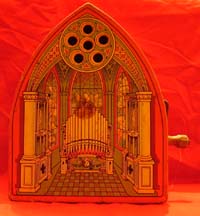
J. Chein Crank Organ
They Play Hymns
Click to Enlarge
Motor Boat
This Chein Catalog number 56 -- a little mechanical boat. This was produced in the early to mid 1950s. Wind it up, place it in the water and watch it go! They are rare because kids did just that. It's about 8 inches long.
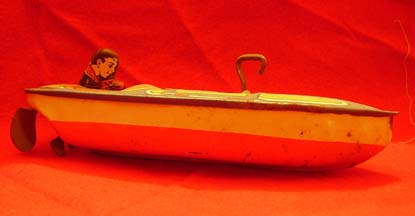
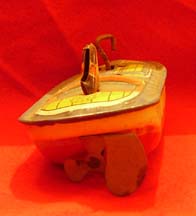
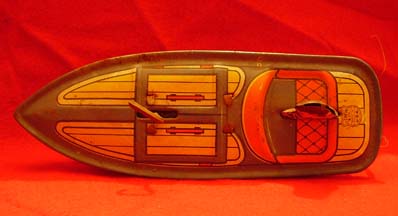
J. Chein Mechanical Boat
It gets up a surprising amount of speed in the water
Click to Enlarge
Aquaplane
This Chein Catalog number 39 -- a mechanical seaplane known as the "Aquaplane". This is one of the unforgettable classic Chein toys. I had one as a kid. Production began in the 1930s and changed little (in shape) into the 1950s Early versions have a cross design on the wings. In 1940, the US Army Air Corps star was used. A silver version was produced during World War II. In 1959, it acquired swept wings, resmbling a jet (the big propellor stayed). during the late 1930s, a larger version was made, emulating the famous Pan-Am Clippers. When wound, it would skim over the water. In turn this contributed to the scarcity of these toys, since the pressed metal was hardly immune to rust.
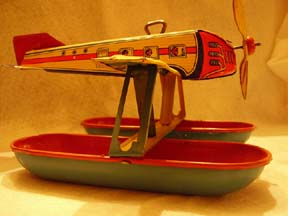
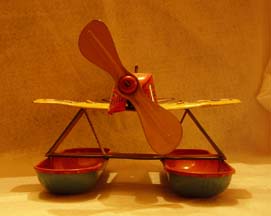
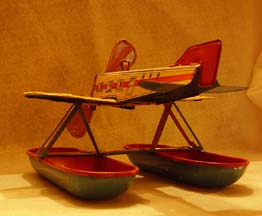
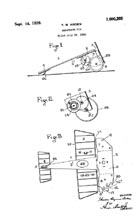
J. Chein Aquaplane
One of the most beloved toys
Patent No. 1,600,202 underlay both the "land" and "aqua" planes
Click to Enlarge
The Aquaplane (along with most Chein toys) was assembled largely by women, ostensibly because they had "nimble fingers" -- in reality, their willingness to work for low wages was probably the real reason. As shown below, work in a toy factory was not all that glamorous.
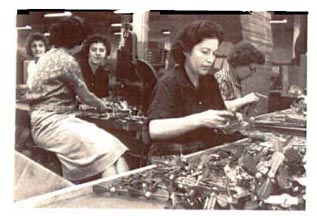
Assembling the Aquaplane
Nimble Fingers and Low Wages
Click to Enlarge
Clipper/Patrol Bomber Flying Boat
Chein made a very nice model of the Sikorsky VS-44 "Flying Dreadnought". Althugh rejected by the Navy, the plane was turned into a fairly successful passenger aircraft.
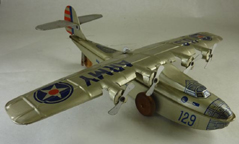
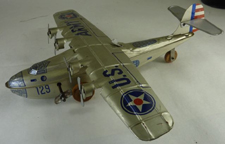
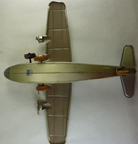
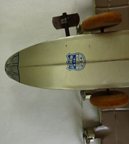
J. Chein Clipper/Patrol Bomber Flying Boat
Click to Enlarge
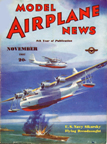
Sikorsky VS-44 (XPBS-1) "Flying Dreadnought"
Model Airplane News Cover Art for November, 1937
by Jo Kotula
Click to Enlarge
After failing to convince the Navy of its merits as a "flying dreadnought", this giant four-engined flying boat was adapted for the trans-Atlantic passenger market, with a capacity of 40+ passengers. Only three aircraft, designated VS-44, were produced: Excalibur, Excambian, and Exeter.
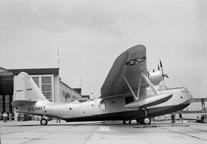
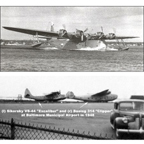
Photos of the Sikorsky VS-44 (XPBS-1) "Flying Dreadnought"
Click to Enlarge
In 1935, the new Consolidated YP3Y-1 (prototype for the famous PBY Catalina had just flown, promising the Navy a long range patrol and rescue craft that was second to none. Even so, the Navy was making plans for a new patrol bomber that would have even greater range, speed and weapon load capability. Prototypes were ordered from Sikorsky in June 1935 and Consolidated Aircraft in July 1936. However, the U.S. Navy did not have funds at that time to procure either aircraft; fifteen months later the contract was given to Consolidated who produced the Coronado. Cut out of the military market, Sikorsky sold the XPBS-1 design to civilian customers as the VS-44.
The Sikorsky commercial version (VS-44) was 30 mph faster and could fly 500 miles further than the competing Boeing 314 "China Clipper", earning bragging rights as having the longest full-payload range of any aircraft in the world.
Here is a video of the Sikorsky VS-44:
Click Here for more information about the Sikorsky VS-44 (XPBS-1) "Flying Dreadnought".
Alligator Toy
"Snappy the Alligator" (Chein Catalog No. 140) is a wonderful toy. He moves along the floor by means of a toothed wheel. A cam causes the jaws to open and shut. Minor imperfections in the mechanical linkages, plus slippage of the wheel on the floor give him a realistic and menacing appearance.
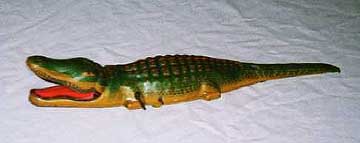
J. Chein Pressed Tin Alligator Toy
Click to Enlarge
Unfortunately, a reader informed me that this is only part of the story! This is another Chein toy, but it is missing a Politically Incorrect part. The original Chein Alligator toy had a "Native" (i.e. a fellow in a grass skirt...) riding the alligator with reins, no less. My specimen is missing this detail (I think that I prefer it this way...). Here is what the complete toy looks like:

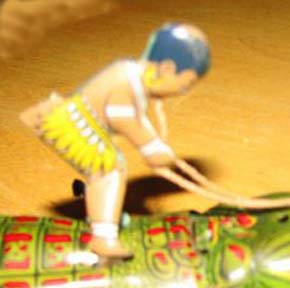
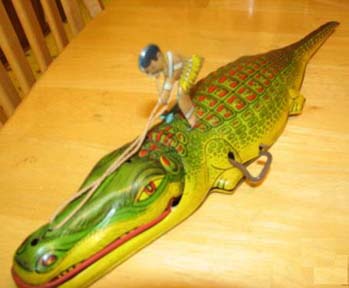
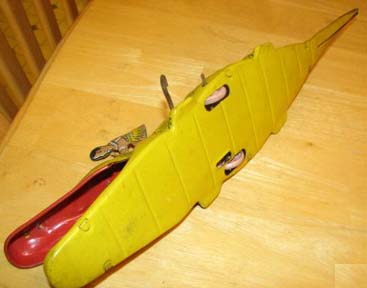
The Chein Alligator Toy
Happy Days Bank
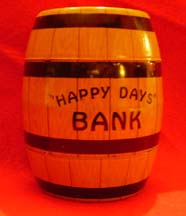
J. Chein Pressed Tin "Happy Days" Bank
Click to Enlarge
The Chein company made a lot of Banks. This one evokes the spirit of the 1930s with hopes of recovery from the Great Depression. "Happy Days are Here Again" was Franklin Roosevelt's theme song during the 1932 campaign. This bank makes a brief appearance at the beginning of the 1942 film Larceny Inc.. As the characters are sitting in a drug store plotting to rob a real bank, the bumbling chararacter "JuG" (Broderick Crawford) tries to break into a "Happy Days" toy bank.
Bosch Radio Globe
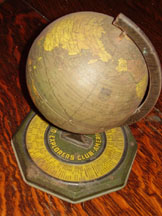
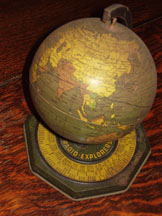
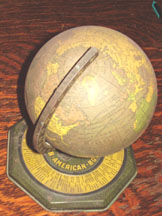
J. Chein Pressed Tin Bosch Radio Globe
Click to Enlarge
The Chein company made a lot of promotional gifts from other companies. This is a globe made for the Bosch Radio Company. In the early days of Radio, listeners were eager to listen to far away stations, especially on shortwave. Receivers with a shorwave band were quite expensive, and this little globe may have softened the pain, because it admitted one to the Bosch American Radio Explorers Club. The call leters of various international stations are printed on the base for reference. The globe is definitely from before World War II, because (middle picture) it shows "Indochina (Fr.)" in southeast Asia (eventually, after more than 30 years of war, this became Vietnam, Cambodia and Laos). Also, you'll note "India" is one country, no Pakistan or Bangladesh. On the left picture, you'll note that Korea is shown as part of Japan. Old globes are very interesting.....
Air France Stauette of the Lockheed Constellation

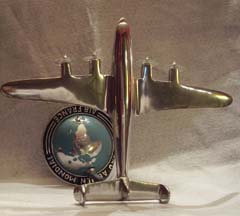
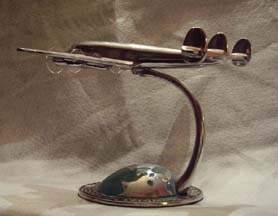

Air France Constellation
Click to Enlarge
The Lockheed Constellation, affectionately known as the "Connie", was a four-engine propeller-driven airliner built by Lockheed between 1943 and 1958 at its Burbank, California, USA, facility. A total of 856 aircraft were produced in four models, all distinguished by a distinctive triple-tail design and graceful, dolphin-shaped fuselage. It was used as both a civilian airliner and U.S. military air transport plane, seeing service in the Berlin Airlift and as the presidential aircraft for U.S. President Dwight D. Eisenhower. In 1939, Trans World Airlines, at the encouragement of major stockholder Howard Hughes, requested a 40-passenger transcontinental airliner with 3,500 mile - well beyond the capabilities existing planes. TWA's requirements led to the L-049 Constellation. The Constellation's wing was effectively the same as that of the P-38 Lightning, differing only in scale. The distinctive triple tail kept the aircraft's overall height low enough so that it could fit in existing hangars, while new features included hydraulically-boosted controls and a thermal de-icing system used on wing and tail leading edges.
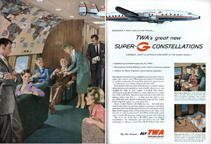
TWA Ad for the Constellation
The headroom is probably exaggerated
Click to Enlarge
The new plane could achieve top speeds of over 340 miles per hour, a cruise speed of 300 mph, and a service ceiling of 24,000 feet. The first Constellation entered service with Pan Am and TWA in late 1945


Patent Diagrams for the Lockheed "Constellation"
Design Patent D-136,352
Click to Enlarge
Click Here to learn how to get free patent diagrams
Howard Hughes was largely behind the Constellation. As Anthony Sampson revealed in his seminal 1985 book 'Empires of the Sky', the intricate design may have been undertaken by Lockheed, but the concept, shape, capabilities, appearance and ethos of the Constellation were entirely driven by Hughes' continual intercession during the design process.
Here is a video made by TWA showing behind the scenes maintenance activity required for the Constellation.
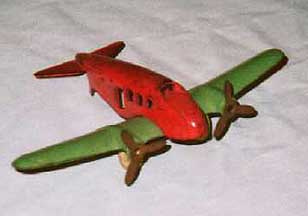
Cast Iron Toy Airplane
Click to Enlarge
Above is a little pressed metal airplane. The dime stores used to be full of these.
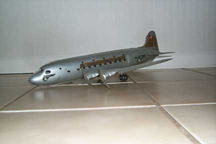
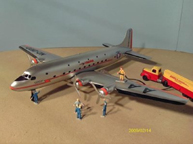
The Marx Pan-Am DC-4
Left: Bob's Plane Right: Tom's Plane
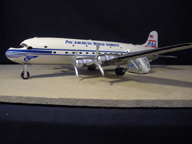 Left: Bob's Plane Right: Tom's Plane
Left: Bob's Plane Right: Tom's Plane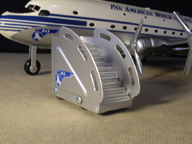
DC-4 with the Marx Air-Stairs
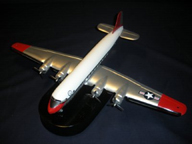
The Marx DC-6
Click to enlarge
First is a pressed tin model of a DC-4, made by the Louis H. Marx Toy Company, sent in by readers Bob (left) and Tom (right). Tom has done some work placing his model in context. Marx also made a DC-6 that was marketed by the "Charlmar" Division (named for his wife Charlotte). [Thanks to reader Tom for this information!]
Below that are two P-80 "Shooting Star" jets sent in by our friend Bob who also has the Rocket Banks (below)
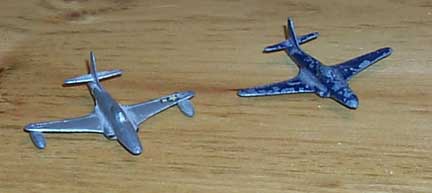
Dinky "Shooting Star" Jets
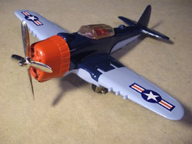
No. 495 Navy Fighter-Bomber
Made by Hubley
Click to Enlarge
Tom says:
"... Hubley's most famous model, The #495 Navy Fighter-Bomber which was based on WWII design. These include the P-47 Thunderbolt, F6F Hellcat, and F4U Corsair. Their thought was to appeal to whatever branch of service dad had served. They came in a variety of color schemes to compliment service usage. The prop spun, the canopy slid open and the wheels retracted. ..."
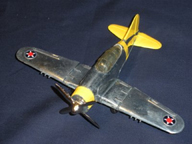
Just "navy Fighter"
Made by Hubley
Click to Enlarge
Tom says:
"... This is the precursor to the #495 and was marketed as the "Navy Fighter. It was a very close copy of the Brewster Buffalo. The Hubley facory was just a couple of hours from Brewster and by the time Hubley had interest in the design, it had long become obsolete. The Navy saw a great opportunity to get the public behind the military so they gave Hubley's designers free reign. This design features retracting landing gear and a spinning prop. This sample came from a Lancaster, PA collection and is in the livery of one of the few Navy squadrons to fly it. ..."
We were very thrilled to get these photos of a lithographed tin model of the Convair B-36 from our reader Bill from Ohio. He writes:
"... If you like airplanes, you're gonna love the [model B-36 shown below] by Yonezawa. It may be my favorite toy. I believe it is the largest tin friction toy airplane ever made. It's pretty hard to find - especially in this near-pristine condition ..."


Pressed Tin B-36
Made by Yonezawa
Check out the Air & Space Museum's B-36 Page
Click to Enlarge
Identification Models
World War Two required a LOT of antiaircraft gunners, on the ground, on ships and in the air. It was of paramount importance that they be able to tell Friend from Foe, especially at a distance. Thus, it was imprtant to train gunners to recognize the shape of various aircraft long before they could see the insignia. Since an aircraft could approach from any direction, three dimensional models were very useful. A wholesale cottage industry sprang up as modelmakers were encourage to volunteer to make "Identification Models". Here is an article from the April, 1942 issue of Popular Science that encourages craftsmen to join the defense effort by making model airplanes.



Models for the Navy
Click to Enlarge
Thanks to our reader Tom, we have some photos of the variety of Identification models that were produced. Some are cast from metal and others are made of resin.
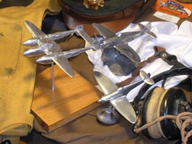
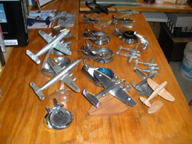
Tom's Collection of Identification Models
Click to Enlarge
These models seem to be very collectable today. I am particularly impressed with Tom's artful photography them of the models with other artifacts of the era.
Rocket and Space Theme Toys
The Berzac Rocket Bank

Berzac Rocket Bank
Click to Enlarge
This is a bank in the shape of a rocket ship. A coin is placed in a little tray (it's on the right side, in the middle of the ship in the picture. The small red button (barely visible) is the trigger that shoots the coin into the bank. The bank has the following markings: "RD 1957 BERZAC Creation, Astro MFG, E. Detroit, USA"
Until February of 2007, I did not have the red nose tip -- then one of my wonedrful readers sent it to me! I do have the key (it is seen taped to the bank at the top left BUT more about that below...)
HISTORY: This bank was widely used as a giveaway at banks. With the rocket standing upright a coin placed in a slot on the side of the rocket shoots up the side of the rocket into a hidden slot under the nose cone. There is usually a decal with the name of the bank across the bottom of the nose . Parts include the Rubber nose cone ( often missing), four rubber fin tips and a key that opened the tail cone to remove the cash. These things fetch between $65 and $80 at auction. Mine would be at the low end because it does not have the rubber nose tip.
We are blessed by an addition from one of our readers! Steve Devoney of Forest Glen, Maryland has sent in photos of his rocket bank. Not only is Steve's bank more complete than mine, he has a Macro Lens and can show you details that my poor little camera cannot.
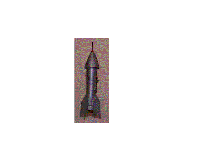
The Whole Bank and Nuthin' but the Bank
Steve writes: "This is an Astro Rocket Bank, made of cast aluminum, dating back to probably the mid 1960's (my guess, '66-67.) Unlike most, this bank has no graphic touting a financial institution or any other kind of company. It's a generic rocket! It comes almost complete with the key and the rubber tip at the top. IT IS VIRTUALLY IMPOSSIBLE to get a bank in COMPLETE condition (more about this below...) because the first things to go were the little rubber caps on the ends of the rocket fins."
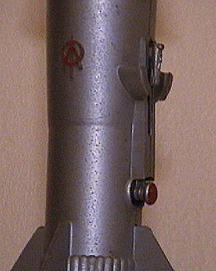
Coin Mechanism
Steve writes: " Here's the coin mechanism. You pull back the 'little rocket' until it clicks into place. Place the coin in the coin holder (from the looks of it, only coins smaller than a quarter can fit, this is definitely pre-Susie B!) Press the red button and 'blast off to savings!' "
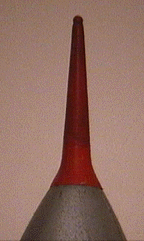
Rubber Tip
Steve writes " Aha! The infamous RUBBER TIP! This is the one that, when missing, renders your AERO ROCKET into a worthless piece of cast aluminum. I'll let you in on a secret-- my grandmother had an Aero Rocket identical to mine. I lost the rubber tip on mine years ago. One summer, I was visiting her house and found the rubber tip to hers under her bureau. The cat had been playing with it. I asked her where her bank was and she said she gave it to some neighbor kid to play with and it never returned. So my grandmother's cat unknowingly saved the most valuable piece of the Aero Rocket. Cats are wonderful creatures...sometimes. "
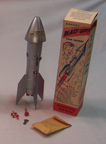
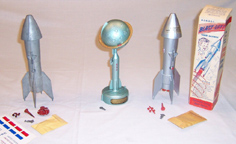
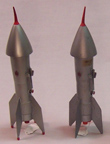
Mint Condition Berzac Rocket Banks
Click on the Photo to Enlarge It
Our reader Ray, who has one of the most complete space-themed-banks collection provided these (above) wonderful photos of totally complete Berzac Rocket Banks. So, it is indeed possible to find a pristine bank with the original box.
Recently, our reader John sent us this:
"... I recently acquired one of these rocket banks when my grandmother passed away. It is complete with the red nose tip and all four rubber feet – but no key. Do you know of a way to open one without a key and/or do you have a picture of what they key looks like so I can send it to my dad so he can look for it as he is cleaning out her apartment? ...
So, specially for John, but with the hope that it will help other readers as well, here is a photo of the keys (thank you, Ray!) that will open the rocket bank as well as the location of the keyhole (on the bottom, in one of the "engines")
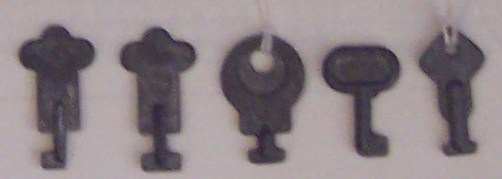
Keys for A Variety of Space Themed Banks
The Rocket Bank Key is the Second From the Left
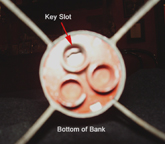
Berzac Rocket Bank Keyhole
Click on the Photo to Enlarge It
Our friend Bob proves once again that it is NOT IMPOSSIBLE to get a complete rocket bank -- he has the most pristine and complete Rocket Bank collection that I have ever seen:
Bob's Completely Mint Rocket Bank
Fins AND Feet!!
Duro-Mold and Other Space-Theme Banks
Bob writes:
"... I visited your website and saw the rocket banks there. In 1968, while in the Army, my parents moved and my rocket banks were thrown out. Why didn't they ask? Maybe they felt a grown man doesn't need his childhood toys? Wrong! I still remember playing with them, take offs and landings, what fun it was! It took me years to find replacements. If you look real hard, you'll find them. I found a case of chrome rocket banks. All mint with all the parts. I included a photo of the chrome banks. I found every model I had. If you're missing something, don't give up as it's out there waiting for you!
Good Luck, Bob ..."

A Portion of Bob's Collection
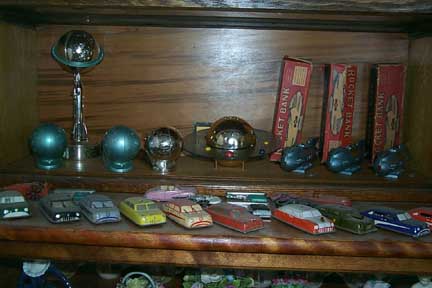
More of Bob's Collection
Note the Original Boxes!

The Flying Saucer Bank


Spaceship Mercury Banks

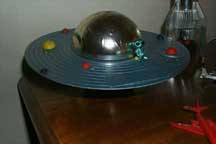
The "Plan-It" Bank
We are indebted to our reader Ray for providing the patent diagrams for all the space-themed banks discussed below. Of note is the second patent drawing from Mr. Berzac. Apparently, his creation was reincarnated as a cocktail shaker in 1967 after the Bank (1960) had run its course:
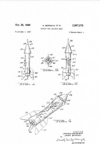
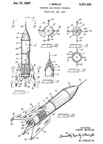

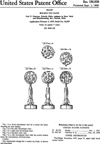
Berzac and Duro Patent Diagrams


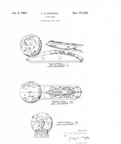

More Space bank Patents
Click on the Photo to Enlarge It
Click here if you want to learn how to get Patent Drawings
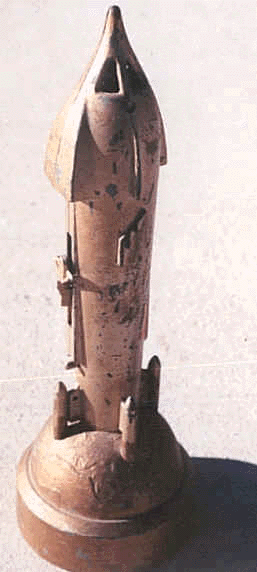
The Duro Satellite Bank
There was competition, even in bank giveaways! Thanks to our friend Lloyd Olsen, here is the Satelite Bank, made by Duro Mold and MFG. Inc, It is cast metal, featuring a vertical gold rocket ship (resting on a globe) with a mechanism at the side for shooting pennies onto the top portion of ship. Like the Astro bank, this was a 50's or 60's giveaway at banks -- in perfect conditon, it might be worth $ 125
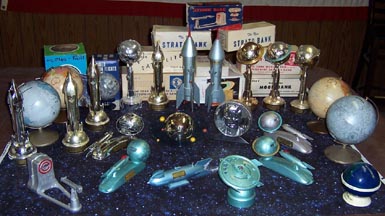
Duro-Mold and Vacumet Space Banks
Click on the Photo to Enlarge It
This is an amazing collection of Duro Mold and Vacumet banks -- plus original boxes - sent to us by our reader Ray. This is an astounding collection that is presented very well. Thanks so much, Ray! Here's more:
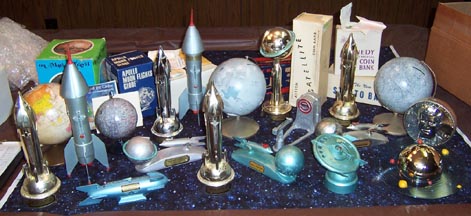
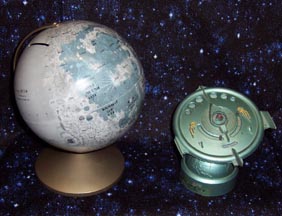
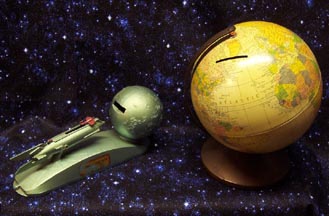
More Duro-Mold and Vacumet Space Banks
Globes of Earth and Moon by Replogle
Click on a Photo to Enlarge It
About a year after we first heard from Ray (i.e. in June, 2010), we received these photos and a note from Ray, who writes:
"... Since last communicating with you I've taken these historically significant American-made mechanical toy banks to NASA's Kennedy Space Center, where all but one of the astronauts I'd spoken with had never before seen them! The curator of the Museum Of Early Space Exploration had never seen them before either, and had since aquired a set of the eight basic model types from me (see picture [on the top row, left] for six of the eight.) They'll hopefully be on display at Cape Canaveral before too long.
I'd also gotten several astronauts to sign a few (top row, right]) and plan on obtaining more when I return this coming November to the third annual Astronaut Autograph & Memorabilia Show sponsored by the Astronaut Scholarship Foundation ..."


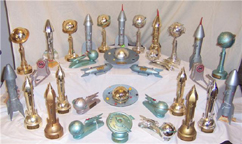
More Space Theme Banks from Ray
Click on a Photo to Enlarge It
In November, 2010, we heard from Ray again, and this time, he shares with us a photo of "Buzz" Aldrin autographing one of his banks. He also shared with us the collection of mint condition banls that have been signed by most of the living astronauts. Check our Ray's website: MacDaddy Banks
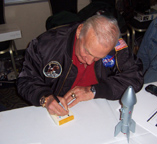
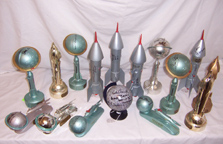
Buzz Aldrin and the Astronaut-signed Banks
Click on a Photo to Enlarge It
Mail-Order Cardboard Rocket Toy
Our next Rocket Toy is absolutely incredible. Those of you who may have grown up in the late 1950s might remember the following advertisement that was in a whole lot of comic books. It promised you a Giant (6 foot long) Rocket Ship for the measly sum of $2.99 (plus shipping..) I think that every kid got burned exactly once by comic book ads -- mine was a "Real Frontier Fort" that turned out to be alarge paper bag printed with western images that was supposed to be placed over a card table. Others got hooked on the "100 Toy Soldiers" ad in which the figures were about half an inch tall. I never paid any attention to the ads after getting stung. Thanks to our friend Bill from Ohio, here is what would come in the mail if you ordered the "Rocket Jet"
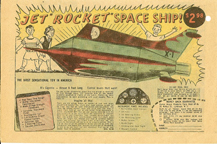
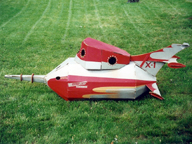

The Rocket Jet as seen in Comic Books Everywhere
Click on a Photo to Enlarge It
You may kick yourself for not sending in for this, because Bill tells us that one of these recently sold for $3,200 in an online auction...
Pyro Plastics Space Fleet
Models of the past are one thing, but here is a collection of Bill's models of the future: Bill says:
"... In the 1950s the Pyro Plastics Corporation based in Union, New Jersey had a grand vision of the future. That vision was represented in their "all plastic" "Space Fleet of the Future." A spacecraft for any mission a 10 year old boy might imagine: X-100 Space Scout, X-200 Space Ranger, X-300 Space Cruiser, and X-400 Satellite Explorer. ..."




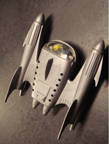
"all plastic" Space Fleet of the Future
Made by Pyro Plastics Corporation
(left to right) X 100 Space Scout, X 200 Space Ranger, X 300 Space Cruiser, and X 400 Satellite Explorer
Check out this really cool Buck Rogers trailer
Click to Enlarge
1950s Science Fiction Cover Art
Bill also sent us some scans of science fiction magazines. He says:
"... I used to collect them. But then I sold the collection. Too much stuff ..."
These covers ar truly amazing and accurately illustrate the "Space Opera" genre of science fiction mixing improbable technology, evolutionary chaos, and soft-core porn in roughly equal amounts. Have fun looking at this great selection of covers!
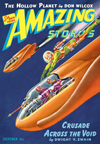
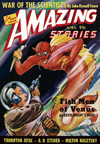

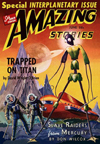
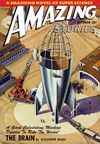
Amazing Stories Magazine
How did the fish men evolve opposable thumbs while keeping fins? Why are they using knives against blasters?
Why does the giant spider have cat's eyes?
If technology has advanced to send men to Titan, whiy are they walking around with spears?
One would think that by 3100, folks could build a monocoque space ship
Click to Enlarge
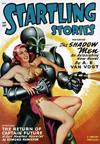
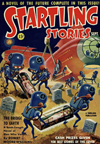
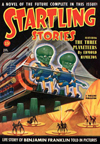
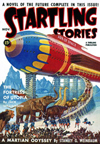
Startling Stories Magazine
Why does the robot have a shoulder defense against swords?
Did they bury all the blondes in pink negligees next to each other?
You'd think that by 3100 flight controls would move beyond stick and rudder pedals...
I hope that in 4500 AD they leave the fleas and ticks off the Ark...
Click to Enlarge
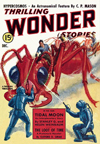
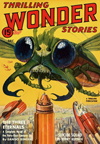
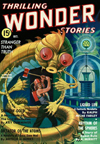
Thrilling Wonder Stories Magazine
The principal threat in the future will be big insects
If the huge Japanese beetle had seen King Kong he would have learned to stay away from skyscrapers...
"Stranger than truth" is no exaggeration...
Click to Enlarge
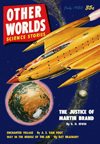
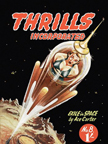
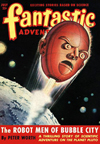
Other Magazines
Other Worlds (July 1950) - the spaceship bears a strange resemblance to The DeHaviland Comet
All women in "Ace Carter" stories have pointed breasts
What "science" is this flying head based on?
Click to Enlarge

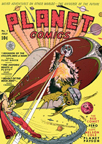
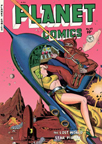
Planet Comics
(left) Why is the lady flying around in a short skirt with no shoes? Won't that jet-pack burn her butt?
(middle) There is apparently one standard rocket design...
(right) Even in 3200 AD they still have open-cockpit fighers
Click to Enlarge
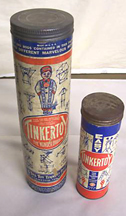
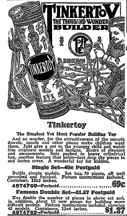
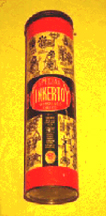
Tinker Toys
(left) 1920s Vintage Sets
(middle) 1929 Advertisement ffrom the Sears Catalogue
($0.69 in 1929 is about $21 in 2009)
(right) "Special Edition" set to make wind-powered toys
Click to Enlarge
A stonemason named Charles Hamilton Pajeau invented Tinker Toys in 1913. Inspired by the sight of children playing with sticks, pencils and spools of thread, he decided to build a playset for children that would incorporate these shapes. The heart of the set was a series of wooden spools that had eight holes on their perimeter and one larger hole through the middle. Also included were a series of cylinder-shaped wooden sticks that could be stuck into the holes of these spools to create all types of three-dimensional shapes and objects.



Tinker Toy Invention and Marketing
(left and right: Tinker Toy patent No. 1,915,835
(Middle) Ready-made Christmas present tags for Tinkertoys
Click to Enlarge
Click here if you want to learn how to get Patent Drawings
After perfecting the Tinker Toys set in his garage, Pajeau took his new creation to the 1914 American Toy Fair. Legend has it that that the Tinker Toys gained their first public fame when Pajeau asked a local druggist to put a display of Tinker Toy windmills with little paper blades in his store window. An electric fan made the little windmills come to life, attracting much attention and prompting people to buy Tinker Toys of their own. Another story claims that Pajeau did not score big at the Toy Fair but made the toys a success later during the Christmas of 1914. He supposedly pulled this off by buying space in a department store window and hiring little people to dress up in elf suits and play with the Tinker Toys.
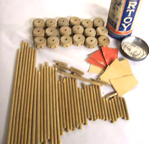

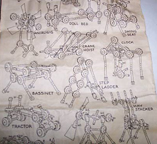
Tinker Toy Components and Plans
Click to Enlarge
Either way, Tinker Toys quickly became a hit. Kids have enjoyed the challenge that Tinker Toys provide for their imaginations, and parents love the intelligent and constructive thinking that comes with the use of Tinker Toys. Because of this combination of fun and mental challenge, Tinker Toys have become an enduring favorite. Although there have been changes over the years (Giant Tinker Toys were introduced for a while, and plastic Tinker Toys replaced the familiar wooden style in the early 1990’s), Tinker Toys remain consistently popular today. As long as parents and kids need a toy that is both fun and smart, there will continue to be a space for Tinker Toys on the toy store shelf.
MORE INFO: Collector's Guide to Tinker Toys by Craig Strange, Paperback (May 1996) Collector Books; ISBN: 0891457038
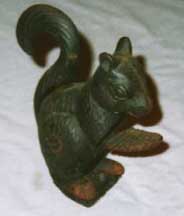
Cast Iron Nutcracker in the Shape of a Squirrel
Click to Enlarge
This is a cast iron nut cracker in the shape of a squirrel. You place a nut in his paw and press down on the tail to crack it. It's sort of a "Squirrel Nut Zapper". (forgive that...)

National Icons Tourist Kitsch
(left to right) Statue of Liberty, Empire state Building, Washington Monument, Liberty Bell Click to Enlarge
Here are some tourist items shaped like national icons. This has some history: the government sold small copies of the Statue of Liberty to finance the construction of the Pedestal. The rest of this stuff is just the logical result of merchandising any national icon.
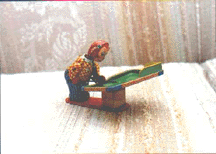
The Pool Player
This photo was sent to us by Charlie from Poplar Bluff, Missouri. Charlie writes: "I was given this wind up clown pool player a few years ago. He stands about 4 inches tall and has 'made in Japan' with what appears to be a hand imprinted on the side of his leg. Other than that I don't know any more about it. I basically collect cocktail shakers, but the clown was kind of interesting..". Write us if you can help identify the figure.

The Etch-a-Sketch
The Etch-a-Sketch, manufactured by the Ohio Art Company is one of my favorite toys. It was invented by Arthur Grandjean of Paris, France as an educational device that would enable one to "trace on a transparent surface all the lines, symbols, drawings and letter-press which may be desired and to wipe them out instantaneously." The French patent application was made on May 28, 1959 and the US patent application was made on July 23, 1959. US Patent 3,055,113 was granted on September 25, 1962.
The original version of this toy was manufactured by Kremlin-Bicetre a Soviet-French cooperative venture. It is unusal that the quintessential American toy of the early 1960s should have its origins with a Russian venture, especially as the period 1959-1965 was perhaps the peak of the Cold War. In the United State, the Etch-A-Sketch is manufactured by the Ohio Art Company of Bryan, Ohio -- this ultra-American company name may have handily concealed the origins of the toy... Who knows, maybe the Etch-A-Sketch was a clever Russian conspiracy to infect the minds of a whole generation of American youth.
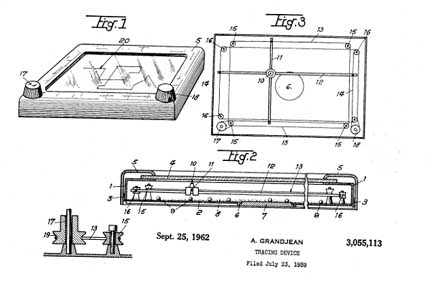
M. Grandjean's Patent for the Etch-a-Sketch
Click here if you want to learn how to get Patent Drawings
Mr. Grandjean's original device was kind of clumsy -- the problem has always been to keep the ultra-fine aluminum powder from leaking out of the box. Indeed, Mr. Grandjean relied on a wide variety of other inventors, particularly those concerned with sealing observation gauges in chemical reaction vessels. He also used rather heavy laminated safety glass for the screen, so the original Etch-A-Sketch tends to look like those old Soviet airplanes or lady weightlifters. It took the work of Mr. Earl D. Clark to render the toy in lightweight, shatterproof plastic. For his work, Mr. Clark was granted US patent 3,760,505. So, there is a patriotic American twist to the tale after all.
As you will see below, lots of other folks have pushed the limits of the toy:
- Click Here to learn how an Etch-a-Sketch actually works!
- Click Here for an on-line version of the Etch-a-Sketch
- Click Here for an on-line gallery of noteworthy Etch-a-Sketch oeuvres
- Click Here for an adaptation of the Etch-a-Sketch for use as an output device for a computer (parallell port...)
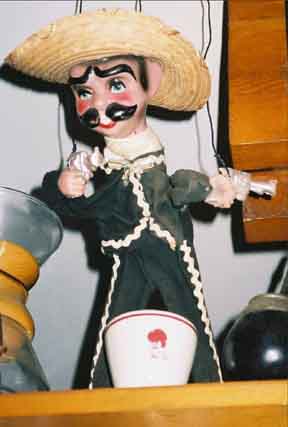
Mexican Puppet
I found this lovely puppet in a Thrift store -- I know nothing about it. Can anyone out there give me more information?
Here is the "Holy Grail" of the pressed metal toy collector; it is the Lil' Abner Family Band, or the "Dogpatch Four".

Lil' Abner Family Band
Based on the famous cartoon strip by Al Capp, this toy has FOUR animated figures and a music box. Pappy Yokum plays the drum, Daisy Mae plays the piano, Mammy Yokum taps out rhythm and Abner tap dances.
This is a tour-de-force of the toymaker's art!
Li’l Abner and his Dogpatch Band is one of the most magnificent examples of tin toy making and design as well as old school mechanical engineering. Watching this toy in action is impressive to say the least. The design of the mechanics that make all four figures move is nothing short of astounding.
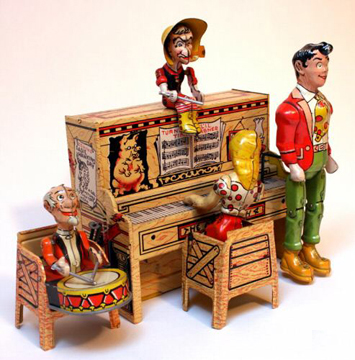
Lil' Abner Family Band - front
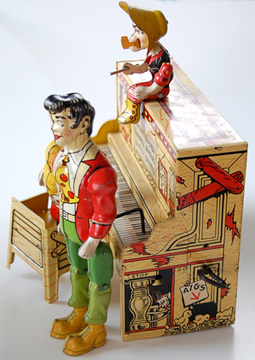
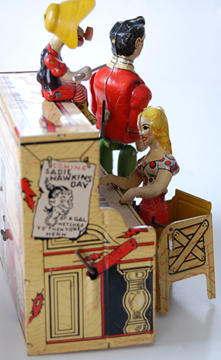
Lil' Abner Family Band Right and Left Side

Pappy Yokum Plays the Drums
This toy is not "Unique" ( a pun on the manufacturer)- it shares much with other animated toys, including the Marx Merrymakers, Ham & Sam, Cowboy Bob & Howdy Doody and others. These toys all have the same concept; a piano player sits and plays while other figures dance and/or play other instruments. The Marx Merrymakers and this toy have all four characters doing the same things. With the Merry makers, the band is comprised of mice in tuxedos. With the Dogpatch band we have all our favorite hillbillies from Dogpatch USA in the same position as as the Merry Makers Mice, doing virtually the same things.
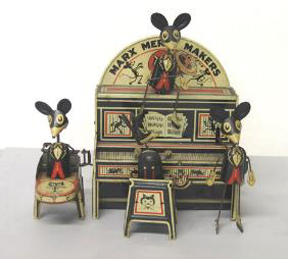
The Marx Merrymakers
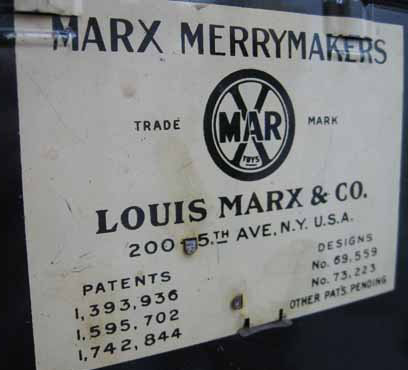
The Manufacturer's Plate for the Marx Merrymakers
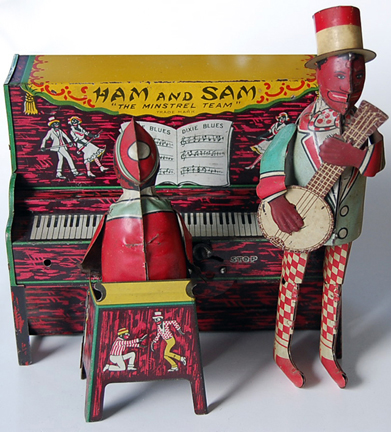
Ham and Sam
Made by the Ferdinand Strauss Corporation of New York
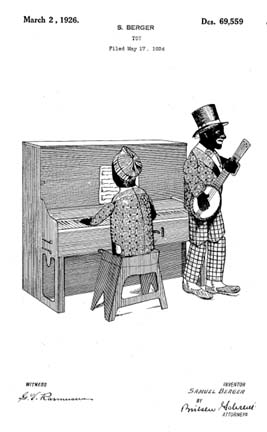
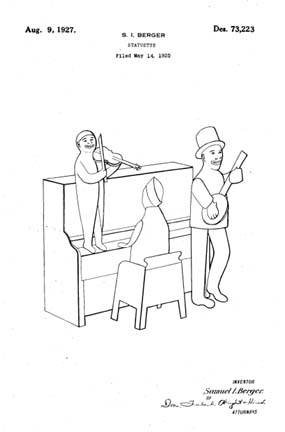
The basic design patents for the Mechanical Band toys
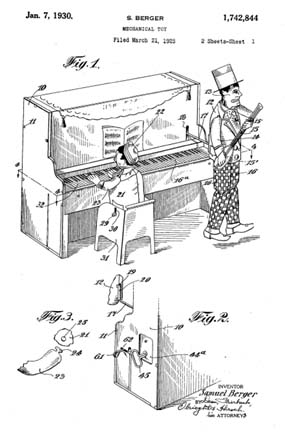
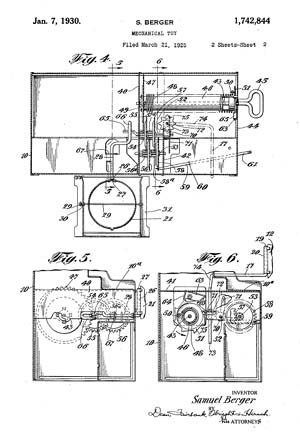
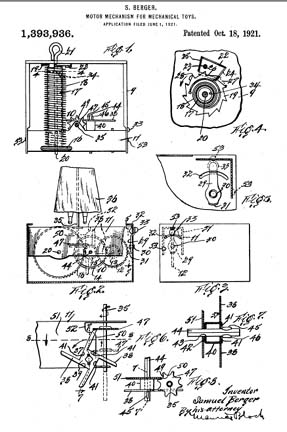
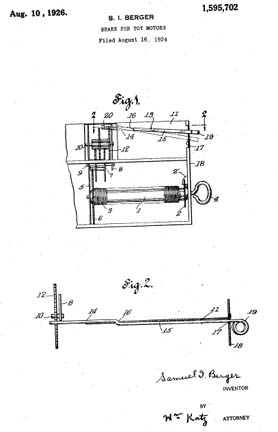
How the Mechanical Band toys work...
Click here if you want to learn how to get Patent Drawings
The "four figure" bands have their antecedents in smaller toys, beginning with single dancers like "Somstepa" (Some Stepper and "Jazzbo Jim", the former by Marx and the latter by Unique. Basically, this toy is just a shaft attached to a wheel in such a way that it moves up and down in the vertical direction. If a doll is attached to the shaft, it appears to do something that looks like Tap Dancing. Prior to wind-up toys, a similar device operated with a foot pedal was a common toy in Appalachia. When the WPA (a New Deal Agency) tried to create an urban market for Appalachian crafts, reporters focused on this toy -- known as a "Boondoggle" -- as an example of wasteful spending (and hence the modern sense of the word as a useless government project)
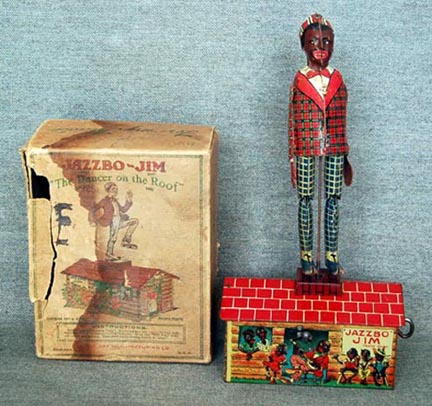
The Jazzbo Jim Single Dancer toy
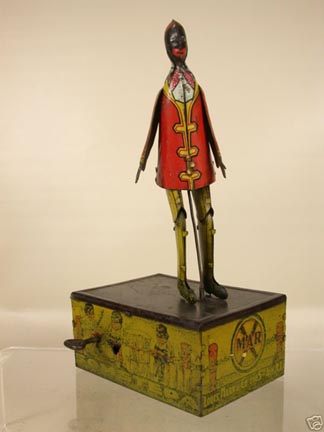
The "Somstepa" Single Dancer Toy
Mechanical bands have found their way into the movies:
- In The Captain's Christmas (Warner Brothers cartoon, dir Tex Avery, 1930) A fake Santa over cranks a single dancer toy and breaks it.
- In Toyland Broadcast (Warner Brothers cartoon, dir. Rudolf Ising, 1934), a roly-poly doll that looks like Paul Whiteman cranks a four piece "Sambo Band" to set off an evening of jazz in a toy store.
Mechanical Bands have also found their way into Museums. Here are some photos taken at the Museum of the City of New York, in which your author is pictured with both the Marx Merrymakers and the Dogpatch Band.
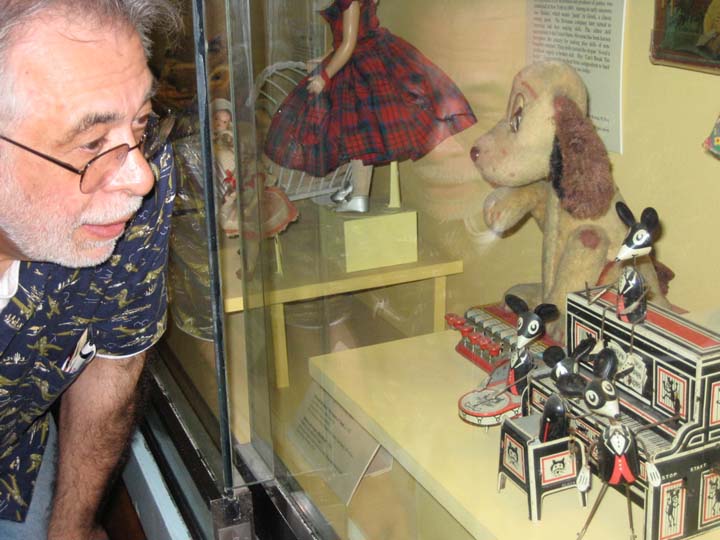
The Marx Merry Makers at the Museum of the City of New York (MoNYC)

Dogpatch Band in MoNYC
These marvelous toys once sold for less than $1 (in 1931), something that would be about $30 in 2009. However, their value today is many times that. Mint-Condition-With-The-Box versions of the Merrymakers routinely sell for thousands of dollars.
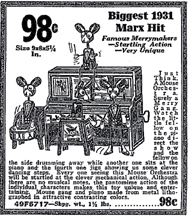

Mechanical Bands and Dancers
Click to Enlarge
The tooling for the piano and the inner workings are the same for these toys. Marx Toy Co. and the Unique Art Co. were known to share tooling and mechanical designs. They would simply change the graphics. A great example of this sharing is Unique Arts Lincoln Tunnel and the Marx toys, Main St., Big Parade and Busy Bridge.
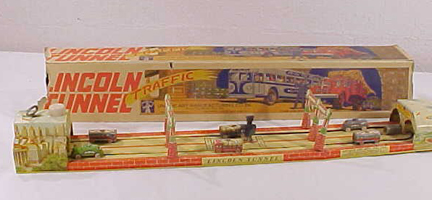
The Unique Art Lincoln Tunnel
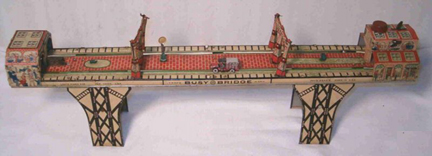
The Marx Company Busy Bridge
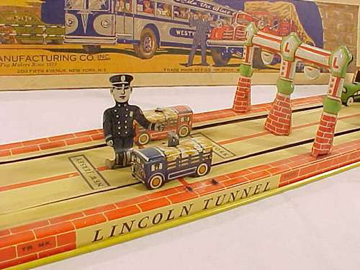
Detail from the Lincoln Tunnel
As shown below, the piano is marked following: "Copr. 1945 by United Features Syndicate, Inc." and "Unique Art Manufacturing Co Inc. Pioneer Toymakers since 1916."
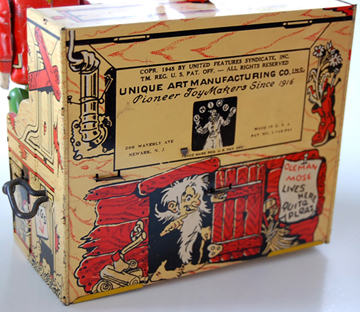
Lil' Abner Family Band, Piano Back
By way of background: LI'L ABNER YOKUM was the title character in the long-running (1934-1977) syndicated newspaper strip by cartoonist Al Capp. Hardly 'li'l,' Abner was a hulking, naive man-child, and the frequent foil for Capp's satiric stories about American life and politics. This simple-minded citizen of humble Dogpatch was a paragon of virtue in a dark and cynical world. Li'l Abner was the unlikely son of tiny Mammy (Pansy) and Pappy (Lucifer) Yokum. Mammy was the industrious 'sassiety leader' of backward Dogpatch who instilled honesty and All-American ideals in Abner. Pappy, in contrast, was an illiterate and hopeless parasite. From the inception of the strip, Abner was vigorously pursued by Daisy Mae Scraggs, a beautiful Dogpatch damsel hopelessly in love with the bumbling, unappreciative and seldom amorous bachelor. Abner spent nearly two decades outracing Daisy in the annual Sadie Hawkins Day race. But the couple finally married in 1952, a fictional event that captured national attention and was a cover story for Life magazine. Their only child, Honest Abe Yokum, was born in 1953. Li'l Abner generally had no visible means of support but he sometimes earned his living as a mattress tester. When not involved in worldwide escapades, he was engrossed by his favorite "comical strip," Fearless Fosdick (his "ideel"), a unique strip-within-a-strip masterfully orchestrated by Capp. Abner interacted with many marvelous and fantastic characters over the years, creating language and situations which have become permanent parts of the American lexicon.
There are many humorous references to characters from the Lil Abner comic strip, including:
- Sadie Hawkins Day in which unmarried women chased bachelors in order to capture and marry them.
- Sadie Hawkins, herself, is at Daisy Mae's right
- Old Man Mose, the seer/hermit, who was clad only in his own beard. His predictions always came true and they were always unpopular.
- The Shmoo a small animal which looks like an animated ham. From its round rump a plumpish neck narrows toward a tiny head; from above a sparse mustache, a pair of trusting eyes peer myopically but ingratiatingly at the world. In the words of the greatest living authority on shmoos: "They lays aigs at th' slightest excuse! (The aigs may be retrieved on the right side of the piano...) They also gives milk. And as fo' meat—broiled, they makes th' finest steaks; fried, they come out th' yummiest chicken." The shmoo is so sensitive and so eager to please that when a human merely looks at it with a faint suggestion of hunger, the animal falls flat on its back and dies of happiness, all ready for the frying pan.
- Salomey, the world's most lovable and succulent pig. A special Ecstasy Sauce, the dream of gourmands the world over, could only be made from a nearly extinct porcine breed -- the Hammus Alabamus -- and it be reduced by complicated means to one flavourful drop. Salomey was the sole surviving member of the breed. Plots to capture and cook Salomey were thwarted again and again thru the years.
- Turnips, Lil Abner's favorite dish (The sheet music is labeled "Turnip Time")
Buyer beware -- there are a number of online sources for a reproduction of the box for this toy. I, personally, would not pay extra for a box becuase of the possibility of fraud. This is what the original box and directions look like:
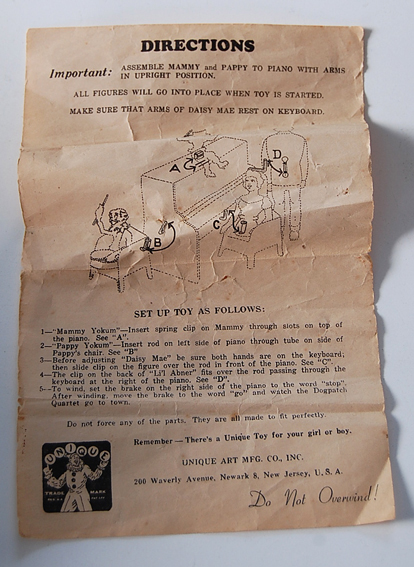
Lil' Abner Family Band, Directions

Lil' Abner Family Band, Original Box
Counter for the Entire Site (not just this page..)
Home | About Lindy | 1940s Collectibles | Upcoming Events | Vintage Clothing
The Guide - Establishments - Travel - Accessories
Music | Links | Photo Gallery | Extras | Contact